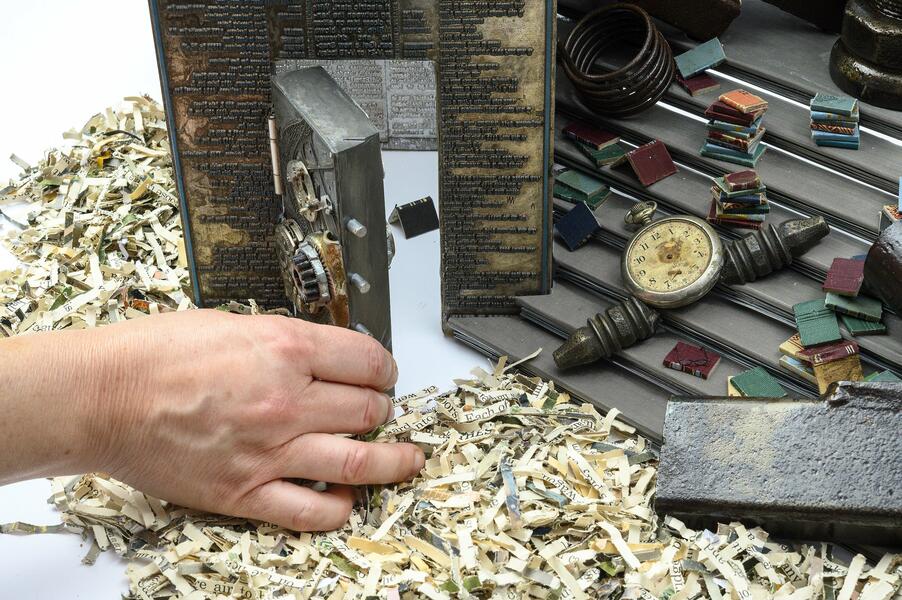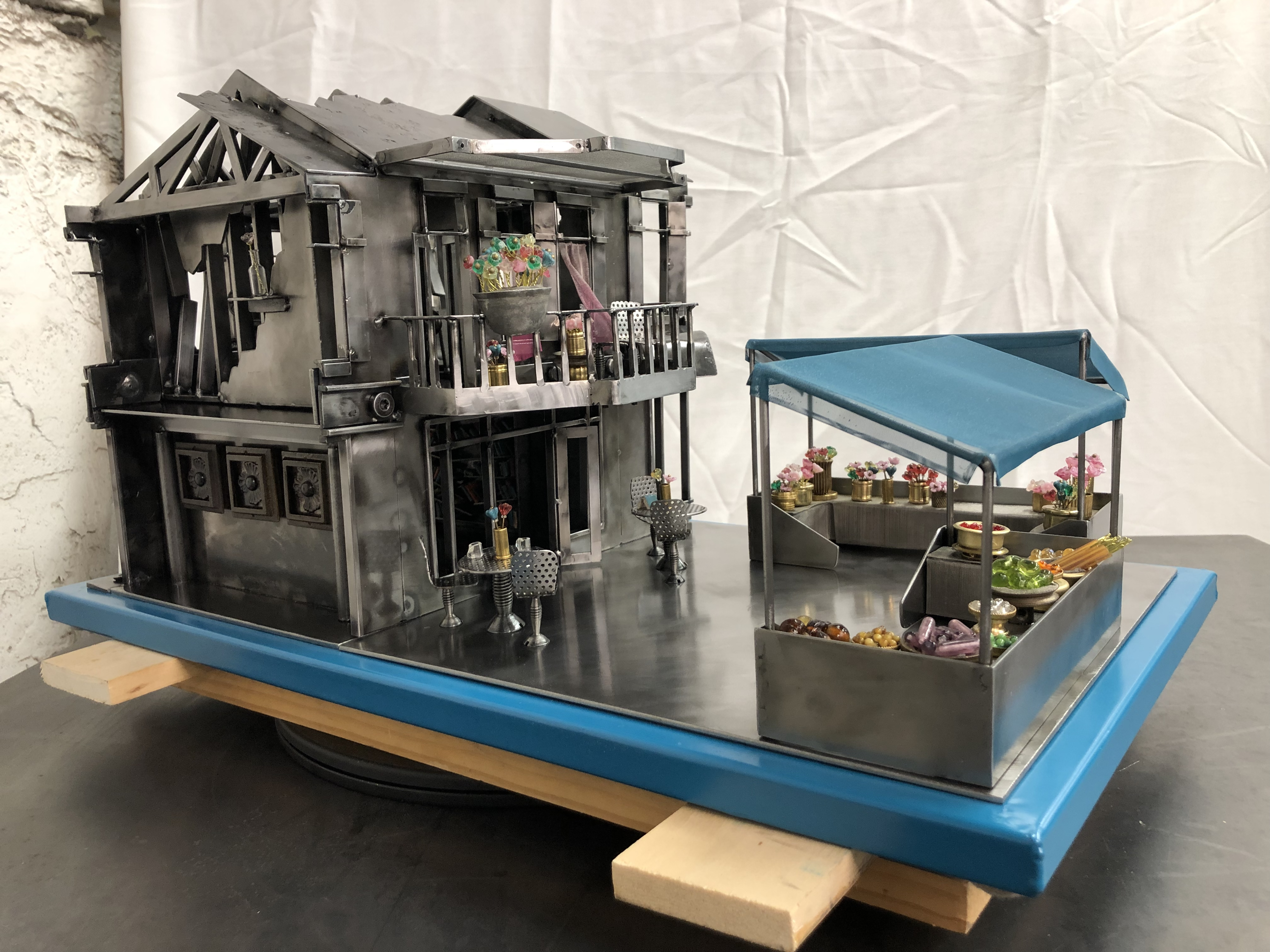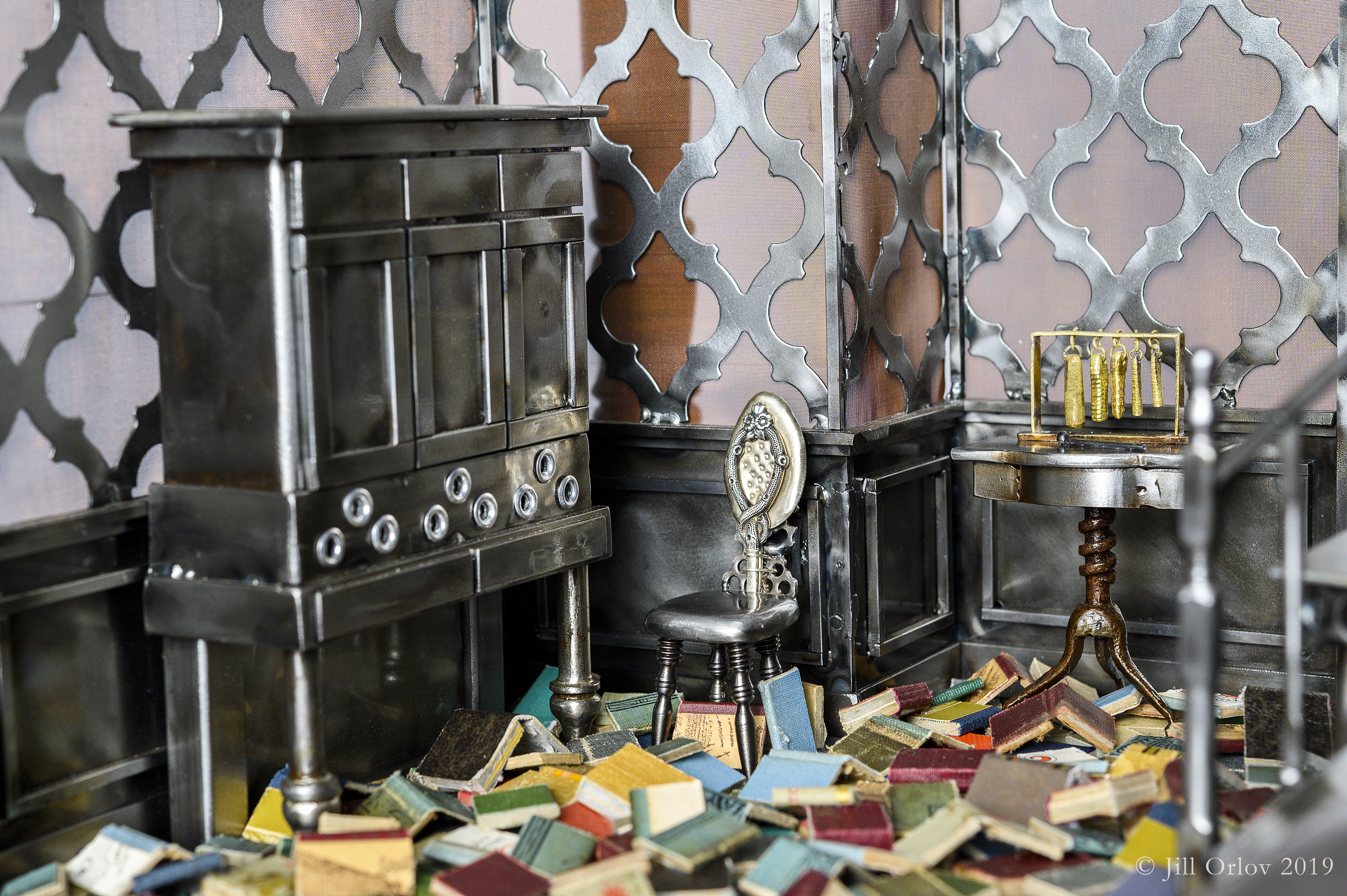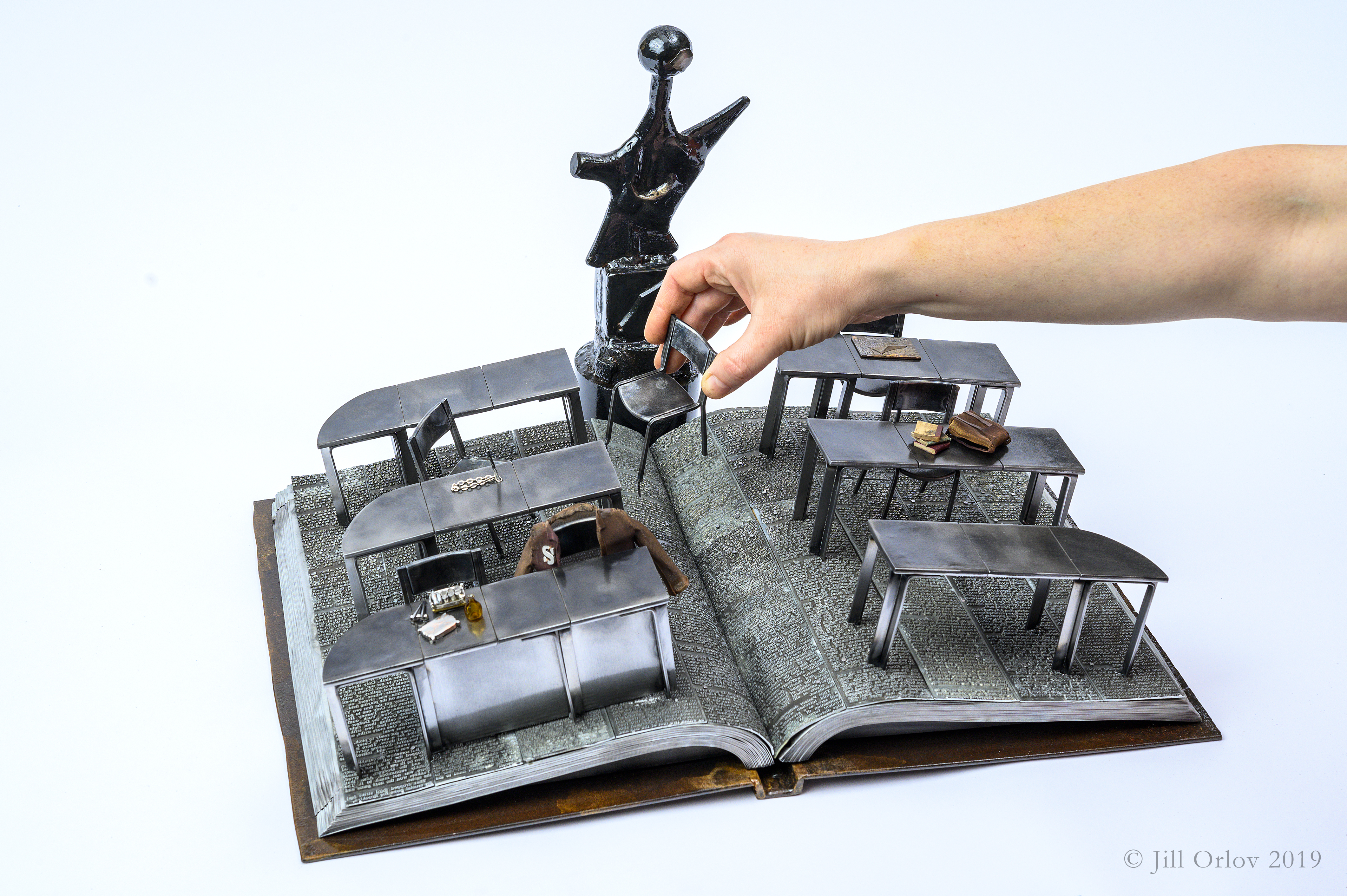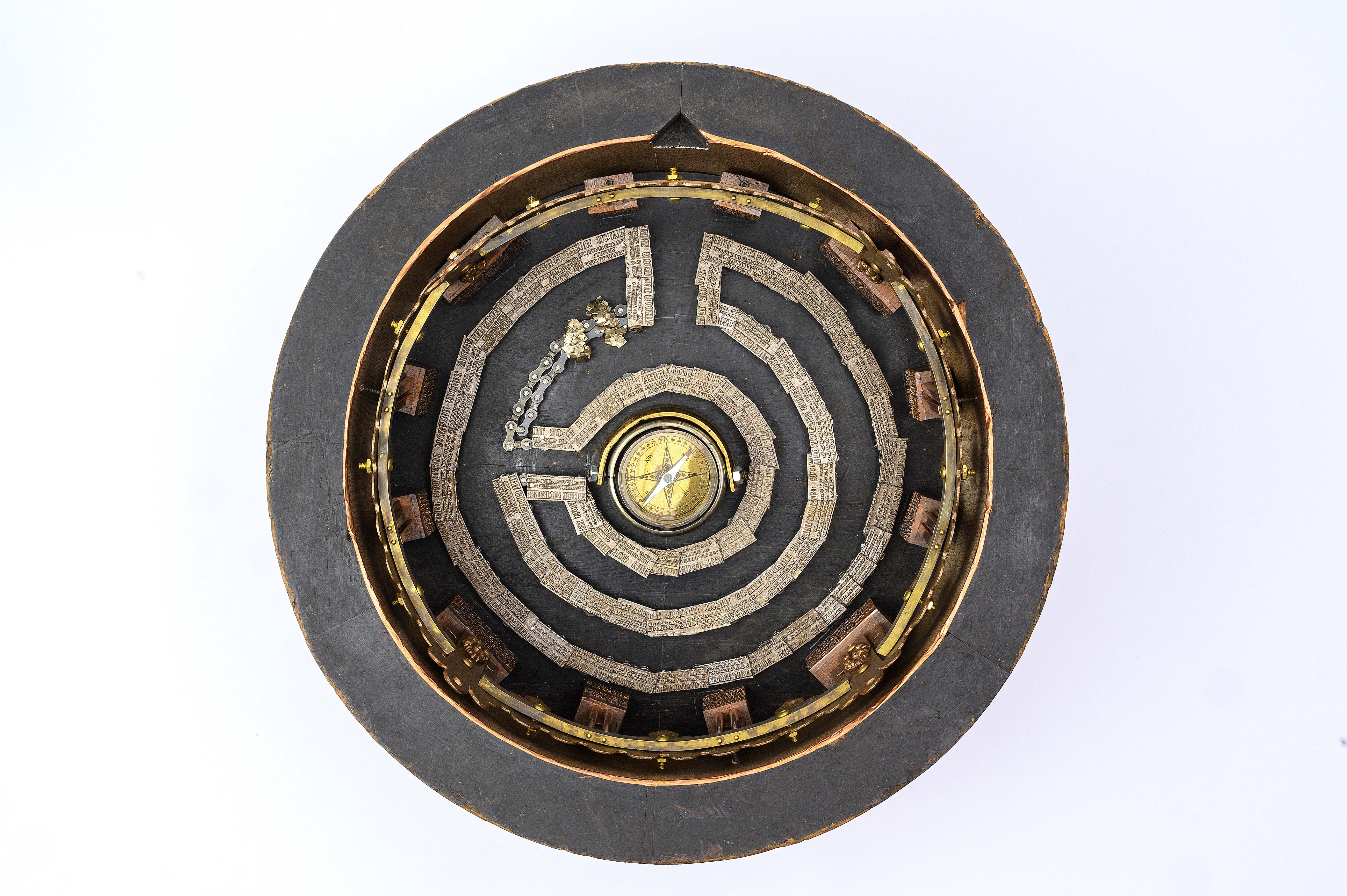Work samples
-
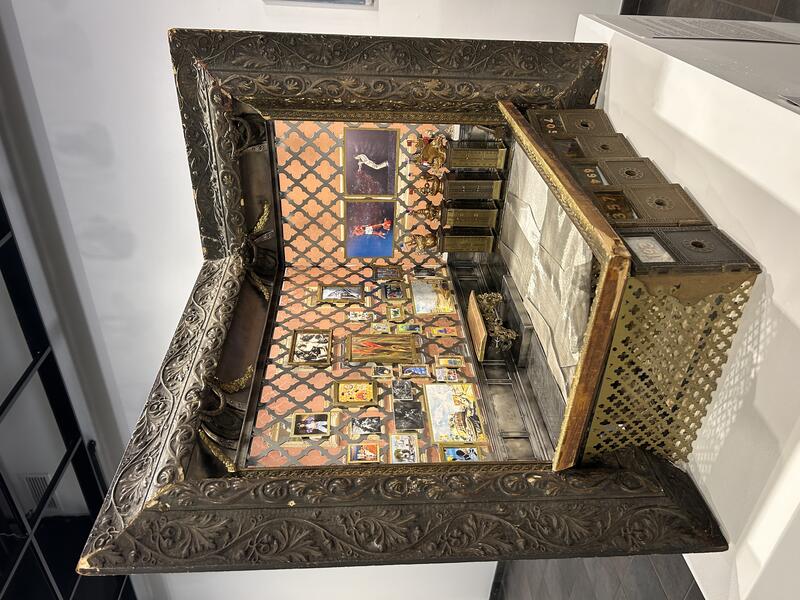 IMG_0035.jpeg
IMG_0035.jpegGallery reFramed - a work in progress. This complex sculptural collaboration is a reinterpretation of the Late Baroque and Neoclassical Art gallery within the Walters Art Museum. The original paintings and sculptures are to be catalysts for new miniature artworks reimagined by artists who are currently incarcerated.
The walls, floor, ceiling cove and table are being fabricated out of welded steel and found objects. The "gilded" frames will be silver soldered vintage brass key shafts.
26" wide x 17" deep x 26" tall. In progress.
-
 Wings of Desire globes and orrery
Wings of Desire globes and orreryWings of Desire. This sculptural vignette was inspired by the dream-like scene in the movie of the same name. An elderly man named Homer reminisces of more peaceful times while Cassiel, the observing angel, listens from the swiveling stool nearby.
14" wide x 15.5" deep x 21" tall. 2019
-
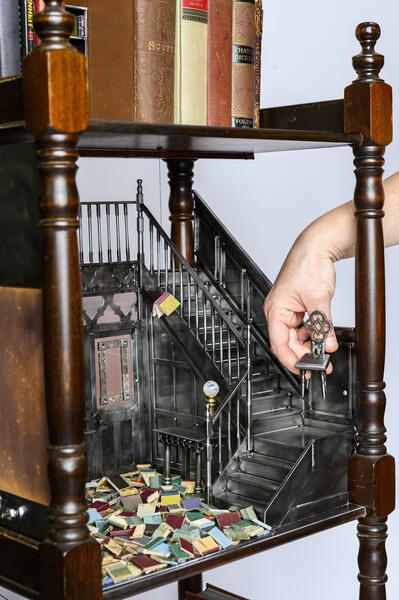 Fahrenheit 451 - parlor scene before fire
Fahrenheit 451 - parlor scene before fireFahrenheit 451. One of a series of six miniature library scenes from film, television and literature. A sculptural vignette of the iconic scene just before all the books are burned in a Victorian parlor. Inspired by Ray Bradbury's novel and Francois Truffaut's 70's movie of the same name.
16" wide x 12.5" deep x 42.5" tall. 2019.
About Jill
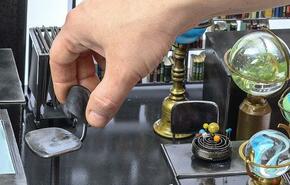
Jill Orlov’s sculptural practice is a culmination of her architectural background and her embrace of working with metals. Miniature scenes and vignettes are thoughtfully yet subtly storied with cultural issues and socially fraught topics. Techniques of welding and soldering, incorporated with carefully selected vintage objects, are used to create these magical worlds. The same heavy-duty techniques at this size disclose the delicate, elemental connections… more
Gallery reFramed
This miniature sculptural scene is a collaborative work-in-progress.
Three experiences, over time, directed my artwork towards the injustices of mass incarceration. During my undergraduate architectural studies, we were given a choice of designing a monastery or a prison… due to their similarities utilizing multiple small cells!!?? Both are based on isolation, but in drastically different ways. That simplified comparison did not resonate with me just yet, but their deeper repercussions stuck with me. Years later I came across a newspaper article about the loneliness of prisoners and how one can become a pen pal. I wanted to - I thought about it often, I fought with my inner cynic, but I never followed through. Then I came across Nicole Fleetwood’s seminal art exhibition and book Marking Time: Art in the Age of Mass Incarceration! One of the highlighted artists was Dean Gillispie, a miniaturist! It was like the world was telling me; it’s TIME for me to do something with the tools that I have, so to speak.
I came up with the collaborative concept of reinterpreting the Late Baroque and Neo-Classical gallery within the Walters Art Museum inviting artists who are currently incarcerated to reimagine the paintings and sculptures … to show the outside world that these people are more than the crime they are charged with. We should understand more about them - their past lives, their dreams, their choices … and maybe find some empathy now knowing about the bloated carceral system of the United States. According to the ACLU, the US contains 5% of the world’s population, but holds over 20% of the world’s prisoners. That is by design and can be traced back to our roots in slavery.
My architecturally informed assembly style and material choices aim to expose the silent systemic injustices inherent to the spaces we, on the outside, do not see clearly. In collaboration with incarcerated individuals, miniature work provides a platform for those who have been marginalized or abandoned by institutions to create art that breaks down barriers with more empathetic and inclusive cultural stories. Reimagining systematic or cultural oppression through miniature sculpture positions those without power to redesign the halls of history with certain autonomy. With the freedom to criticize, critique, and redesign spaces from new perspectives, artists can interrogate the present-day forces that insist on preserving the status quo.
Visually, the existing gilded frames adorning the rich brocaded walls and the pedestaled sculptures exemplify the classic salon style gallery. The evergreen debate of what constitutes Great Art is juxtaposed with the scourge of America’s excessive carceral system. Having spent several months developing relationships with four artists (and counting) who are currently imprisoned around the country through letter writing and proprietary email systems (definitely not your average GMail), I continue to take all the communication challenges each program presents and incorporate them into the sculpture. This collaboration, ultimately, will shine a much-needed light on a nearly forgotten, purposely hidden, community – those serving excessively long sentences in what is planned injustice of our nation’s justice system.
A vintage formerly gilded ornate frame has been mitered to enclose and reinterpret the space of the Baroque NeoClassical gallery within the Walters Art Museum. I am in the process of recreating the brocaded wallpaper, wood paneling, herringbone floor, intricately detailed coved ceiling in my medium of steel and stainless steel mesh. Brass findings are repurposed; vintage drawer handles as ornate cove ceiling details linking parallels to privacy and ownership while upside down vintage brass mailbox doors are reminiscent of cell doors. Under the floor will house the letters of correspondence between myself and the artists who are currently incarcerated, some for life. We write to each other about the conditions, what art means to ourselves, lack of warm clothing, isolation (one was kept in his cell for days on end, even for meals, because 300 guards were fired due to corruption), dreams, and memories. Their visualized stories will illuminate the injustices of excessive prison sentences and inhumane conditions. Education, redemption, and especially prevention should be the focus. Rarely should life in prison or worse, be the norm. These practices have been proven not to be deterrents to crime.
The gilded frames will be created from the shanks of vintage keys, drawing attention to the lack of safe possessions. Ownership, privacy, personal space, autonomy are all that the incarcerated do not possess. Locked away and forgotten, they share and tell their stories and life experiences through their art using images of the original masterpieces as catalysts and sparks of inspiration. This newly curated gallery will share their visions, experiences, and conditions with the outside world. Will we gain empathy and understanding of the inhumane prison system practices?
I have talked to State Delegates, law school professors, and reached out to judges looking for venues to display the finished collaboration when it is ready. Plus, I have met two journalists working for the Marshall Project. I have shared the work with one of them and will be reaching out to the second, only meeting him in person briefly. A huge part of the process is the communications and learning from these artists and what they share and ask.
I will be paying the collaborating artists, who are currently incarcerated, for their materials and finished paintings. I already pay for our email communications, coming and going, and will continue to do that - these are contracted email systems (definitely not GMail). I hope to keep in contact with some of these artists after this collaboration is over. I also have material costs, including what I have already purchased to get the project started to convince the artists to be involved. Shipping, photography, and printing costs are and will also be required.
-
Gallery reFramed
Gallery reFramed - a work in progress. This complex sculptural collaboration is a reinterpretation of the Late Baroque and Neoclassical Art gallery within the Walters Art Museum. The original paintings and sculptures are to be catalysts for new miniature artworks reimagined by artists who are currently incarcerated.
The walls, floor, ceiling cove and table are being fabricated out of welded steel and found objects. The "gilded" frames will be silver soldered vintage brass key shafts.
26" wide x 17" deep x 26" tall. In progress.
-
IMG_1761.JPG
Gallery reFramed - a work in progress. Reimagined museum gallery in miniature. Walls, floor and ceiling cove are welded steel. Other details are vintage brass found objects. This complex sculptural collaboration is a reinterpretation of the Late Baroque and Neoclassical Art gallery within the Walters Art Museum. The original paintings and sculptures are catalysts for new miniature artworks reimagined by artists who are currently incarcerated around the country. 26" wide x 17" deep x 26" tall.
In progress.
Photocopy of original paintings used for layout purposes only.
-
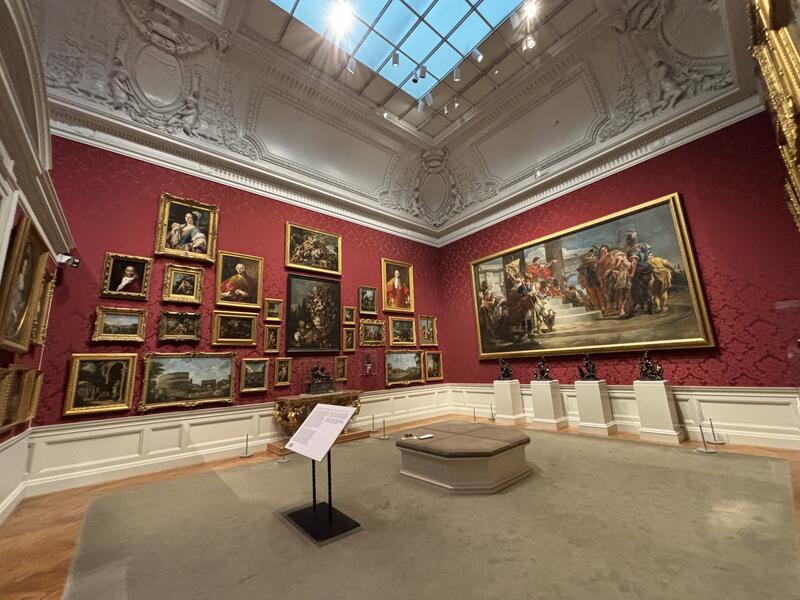 Late Baroque and Neoclassical Art gallery in the Walters Art Museum
Late Baroque and Neoclassical Art gallery in the Walters Art MuseumLate Baroque and Neoclassical Art gallery in the Walters Art Museum - my inspiration.
-
IMG_1770.JPG
Vintage brass drawer pulls are used to represent the ornate plaster details of the ceiling. Vintage slide rules are repurposed for the transition from wall to cove
-
Gilded frame
Gilded frame has been reimagined using vintage brass key shanks calling attention to the lack of secured possessions. One prototype has been made so that I could send an image to the artists, who are currently incarcerated. Some of the artists will paint "full scale" and ship the finished pieces to me. I will have them photographed and printed at the scale required for the miniature gallery wall. Then final frames will be made once the miniature paintings have been created or printed.
Photocopy of original paintings used for layout purposes only.
-
Ornate table top
Vintage brass ruler has been repurposed as a heavy marble table top. Silver soldering techniques were used to connect three 1/4" thick sections using THREE gas torches.
The table base has been repurposed with two Victorian drawer pulls. Legs have not been added yet.
-
Four pedestals
Four pedestals are recreated using solid brass rulers over a wood substrate. One of the artists, currently incarcerated for life, will reimagine the four sculptures using techniques he has perfected in prison. The original sculptures are allegorical representations of the "four quadrants of the earth" - Europe, America, Asia and Africa - cast in bronze by Francesco Bertos in the late 1600's/early 1700's. Our conversations go back and forth about how to reinterpret them. We bounce ideas off each other weekly. Before he knew I was making the entire "mitered frame" sculpture to be viewed from all sides, he asked what the back looked like. He has been full of creative ideas. I can not wait to see what he comes up with.
Before and After - a sculptural interpretation of life during debilitating pain and life after relieving medication
I was commissioned from late 2021 to early 2022 to create a two-sided sculpture representing how a person suffering from debilitating headaches felt before pharmaceutical help and then how her life changed once on the prescribed drug to help prevent the recurring pain. She described her life in the "before" as the "end of the world" in which "the walls were caving in" and she just wanted to remain in bed in dark isolation. The "before" side of the vignette represents her desperation within her home. The facade, the roof, and the walls are collapsing in on themselves. A dark bedroom sits above a library with fallen bookshelves. Once she found the medical relief, she described life as "a breathe of fresh air". This side of the sculpture depicts the same house mirrored but now intact with a balcony overlooking a farmers market with the curtains fluttering in the breeze and flowers blooming on her railing.
The client provided her testimony and a historic image of a bombed Irish village. They gave me total freedom as I took it from there.
12" wide x 24" deep x 12" tall
-
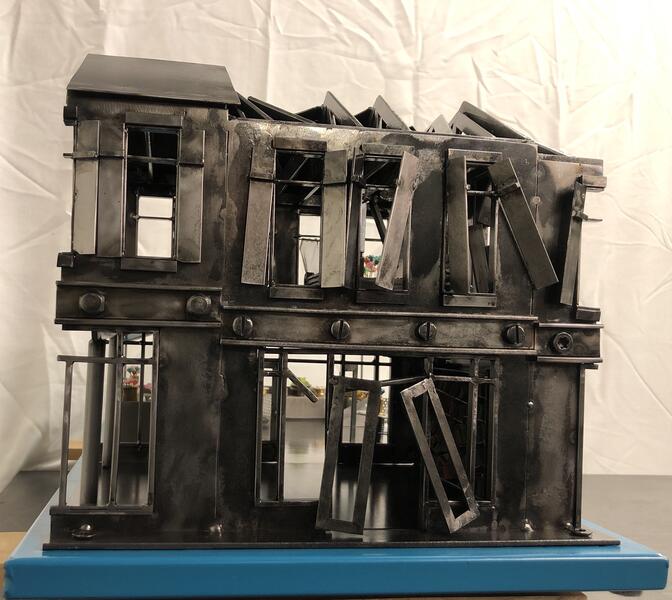 dark front elevation
dark front elevationThe "before" elevation - 12" wide
-
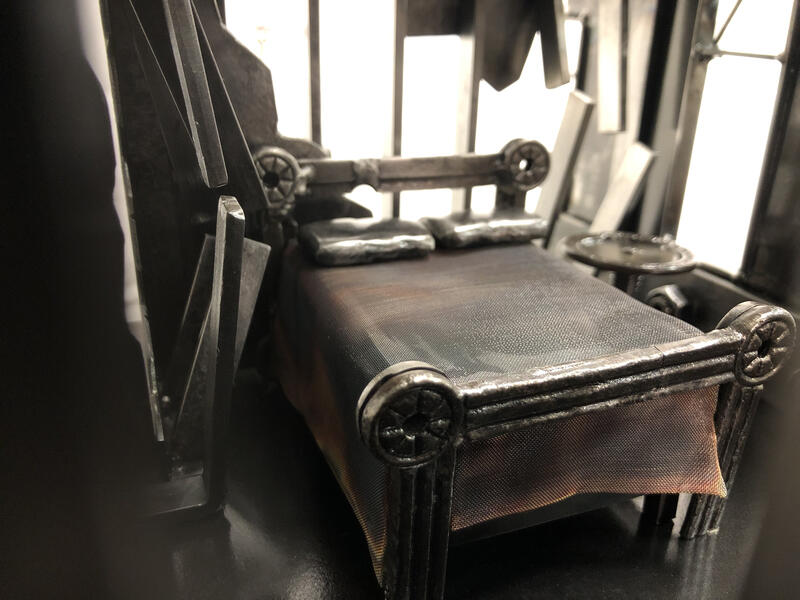 dark bedroom before
dark bedroom beforeDark bedroom with walls caving in - the "before"
-
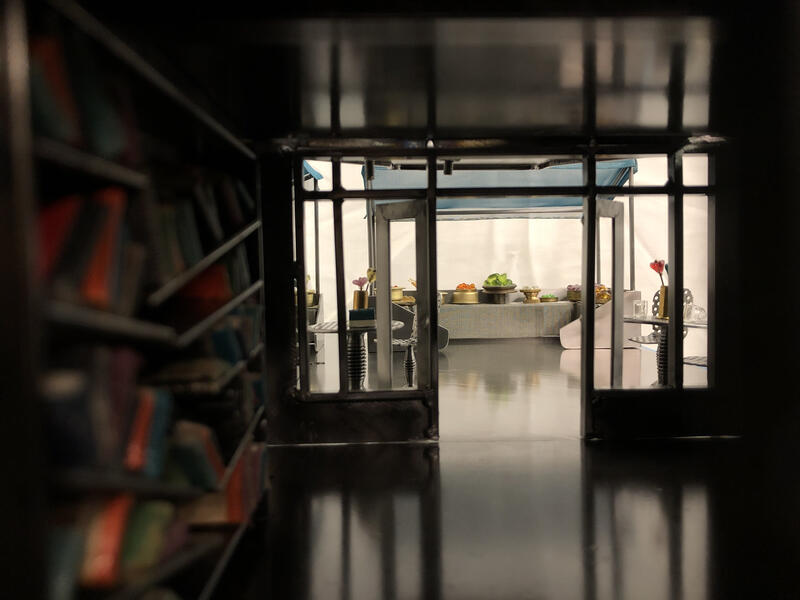 Before side library with peak of the after
Before side library with peak of the afterDark library with collapsing bookshelves in the "before" but a peek of the "after"
-
 The "before" and the "after"
The "before" and the "after"View from the "after" side showing the bistro seating and farmers market with stalls in the shape of the box the medication comes in and with curtains "blowing" in the wind - made of stainless steel mesh
-
Finished sculpture seen from all sides
This is a two-sided sculptural vignette was created as a commission. It is made primarily from welded steel including found objects of cast iron; miniature glass beads and bottles; and painted/formed stainless steel wire mesh.
12" wide x 24" long x 12" tall
-
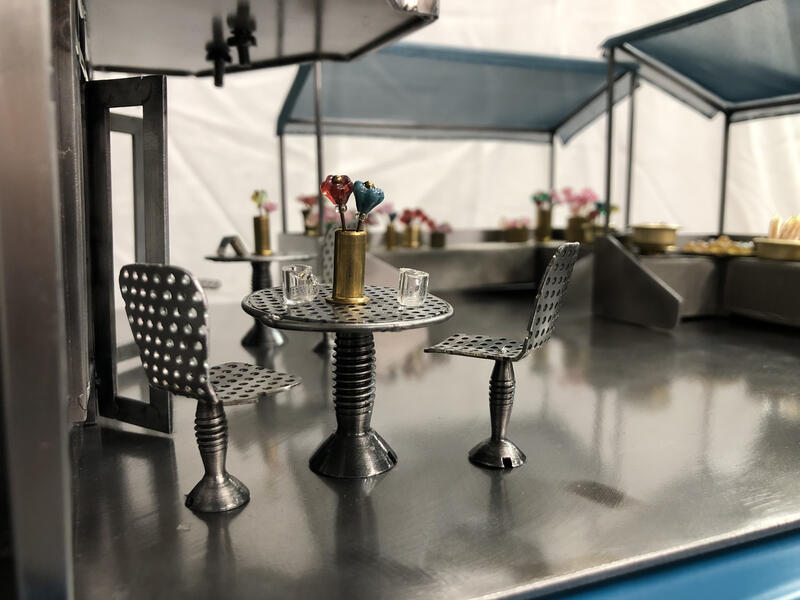 Cafe overlooking the farmers market
Cafe overlooking the farmers marketThe tiny bistro seating consists of chairs and tables made of perforated steel and vintage bolts shaped in an electric drill against a belt sander - a makeshift lathe.
-
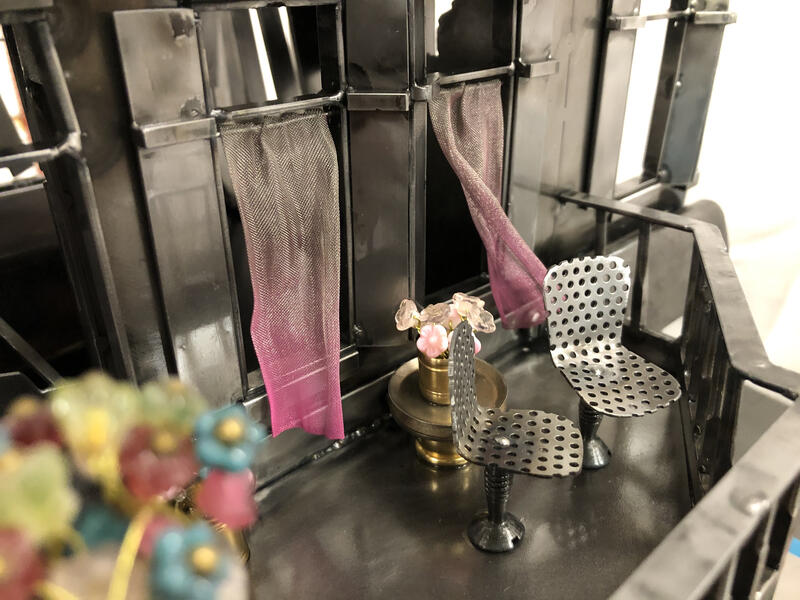 Balcony with breeze catching the curtains
Balcony with breeze catching the curtainsTranslating the patient's description of life "after" being on preventative migraine medication as a "breath of fresh air", I made curtains of stainless steel mesh as if they were blowing in the wind.
-
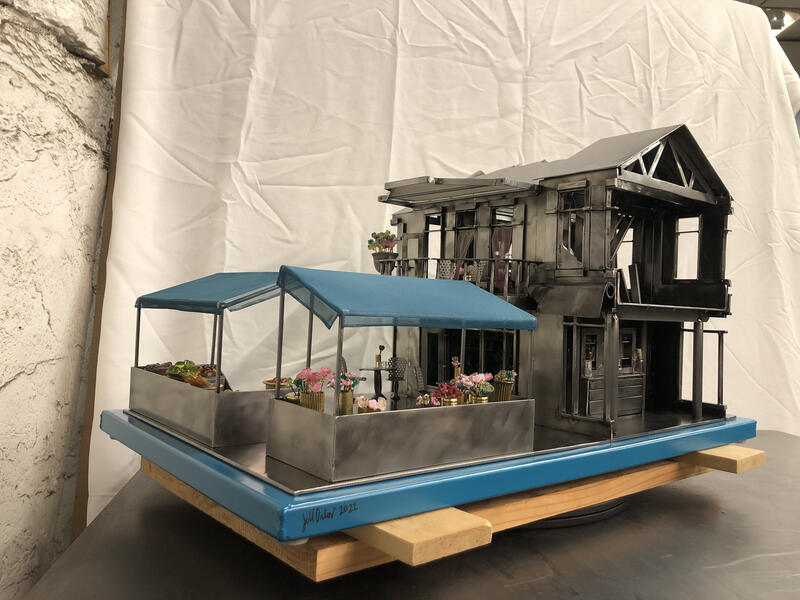 The "after" side overview
The "after" side overviewThe tiny farmers market stalls are the same dimensions and shape as the box that the migraine preventative injection comes in, as are the balcony and awnings.
-
Cut down version of the final video
A full length video was made of the finished sculpture by the production company that commissioned the work. I was provided this clip that was safely without any product naming placement.
-
Cut down version of the entire fabrication process over 2.5 months
The production company had me video my process for 2.5 months (7 days a week) of fabrication that was edited down to less than 3 minutes.
Wings of Desire
I want to live in that world. This common response to my miniature spaces and sculpture expresses how scale can awaken imaginations and transport viewers. By compressing time and space, miniaturization as an art form tangles with nostalgia, commingling historic and fantastic forms. As a result, viewers are enchanted by scenes they can see clearly with their eyes but inhabit only with their imaginations.
My original plan was to recreate the scene where one of the main angel characters, Damiel, is overlooking the shoulder of a young man reading while other angels sit on the balcony ledge. That scene is embedded in my porous memory as ethereal yet wishful. Don't we all wish we had an angel sitting nearby? These were not guardian angels though; they were only observing angels. They felt the emotions that humans felt but could not intervene. There are heartbreaking moments in the film. I came across a 41 second scene where Homer, an elderly man, climbs the library steps and sits down surrounded by these glowing globes. As he stares at a spinning solar system model, an orrery, he daydreams: “The old man wonders why we cannot just have peace but always war. If he gives up, mankind won't have a storyteller, and humans will forget their childhood.” The globes lack delineation, man-made boundaries. Thus, a library provides endless trajectories to travel and dream, even if they are physically enclosed spaces. There is an omniscient feeling evoked in my wall-less sculptural interpretation, similar to what the observing angel might have felt. Watching yet helpless.
One of a series of six miniature vignettes I created inspired by famous library scenes from film, literature, and television series. This movie, of the same name, represented a formerly divided city of Berlin, with commentary on boundaries and freedoms in times soon after the war. The film was purposely shot in black and white scenes to set the somber tone but when one of the main characters, an observing angel, wishes to leave his immortality to SEE color, to FEEL the weight of a stone, and to LOVE a trapeze artist who wears angel wings, the movie gradually shifts to color.
14" wide x 15.5" deep x 21" tall. 2019
-
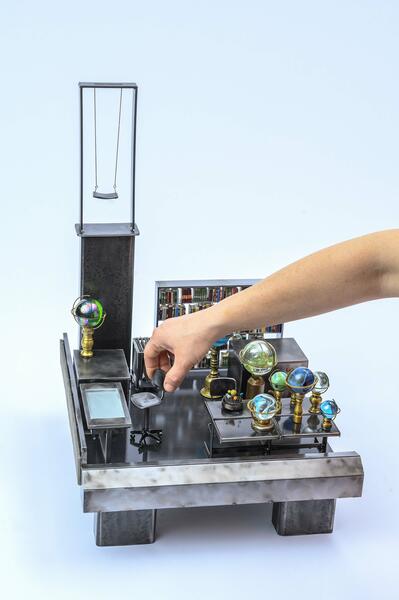 Wings of Desire
Wings of DesireTIG welded steel, glass marbles, silver soldered brass lamp parts, jewelry chain, tiny fabric covered books
-
 Wings of Desire bar stool
Wings of Desire bar stoolThis is the stool representing the presence of the observing angel, Cassiel. It swivels to face the desks with globes and a single chair. The empty chairs is where the contemplative older man, Homer, sat.
-
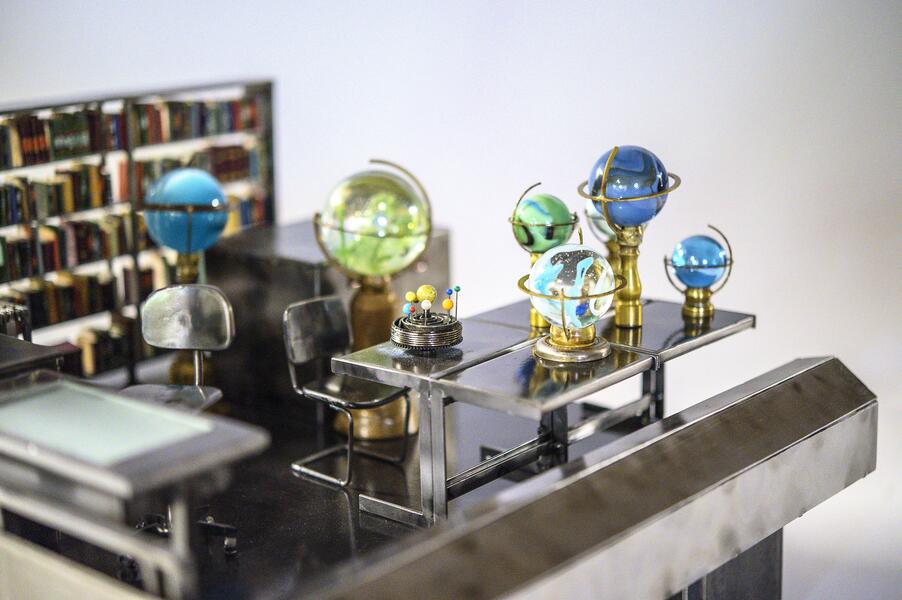 Mini globes and solar system orrery
Mini globes and solar system orreryMiniature orrery, a spinning solar system, and globes made of glass marbles. Tiny books on shelves in the background. No walls enclose this sculptural vignette evoking the lack of boundaries provided in a library. In this case, a library scene set in Berlin soon after the Wall came down, a physical barrier broken.
-
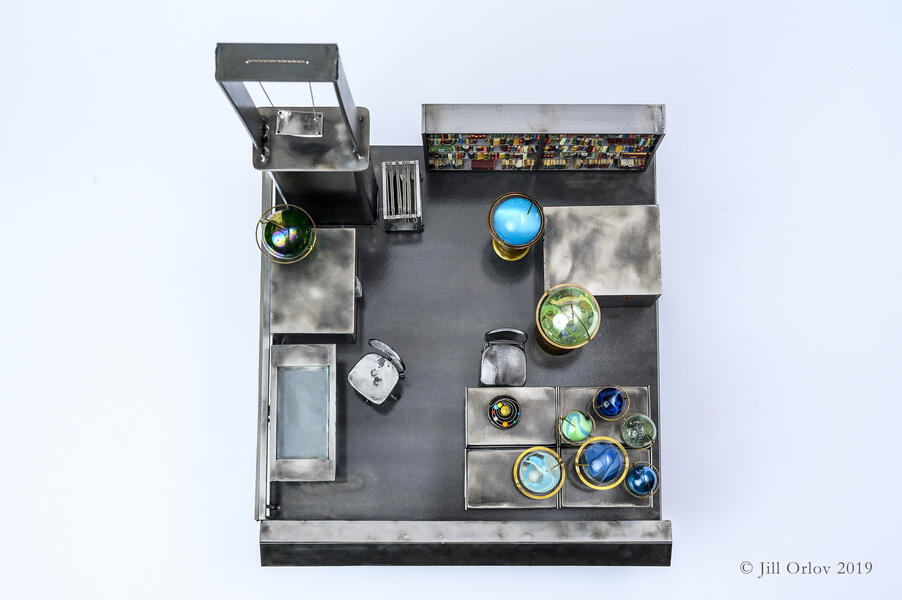 Wings of Desire bird's eye view
Wings of Desire bird's eye viewWings of Desire - bird's eye view from above. Grey tones of welded steel miniature furniture offset by bright green and blue glass marbles.
-
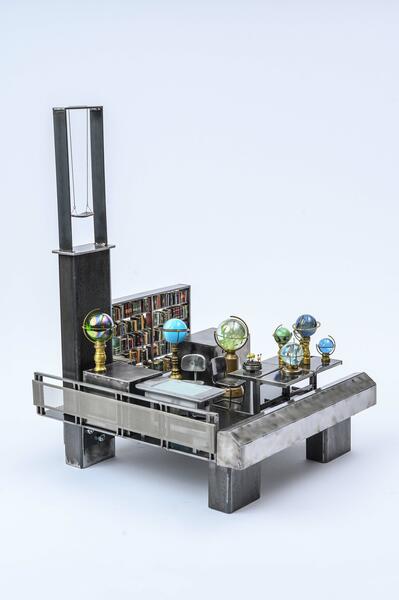 Wings of Desire - view from balcony side
Wings of Desire - view from balcony side -
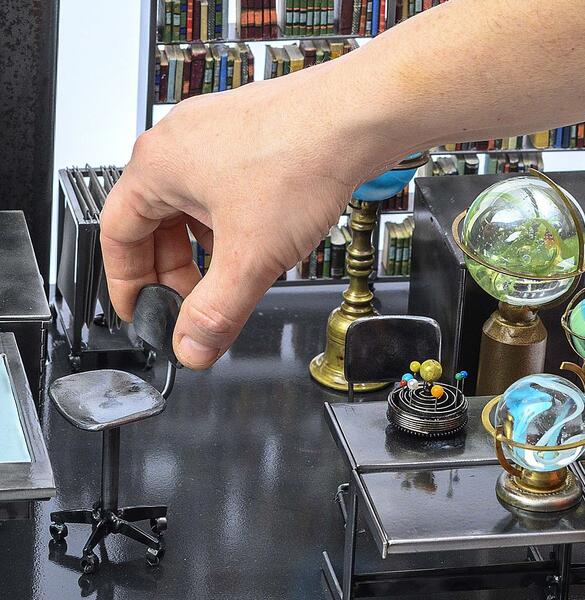 Wings of Desire close up
Wings of Desire close upAn ethereal, dream-like sequence of an observing angel listening to the thoughts of Homer, who is reminiscing of more peaceful times. The two characters are represented by an empty chair and an empty bar stool.
-
 Homer and Cassiel
Homer and CassielWings of Desire - Homer, the old daydreaming man, and Cassiel, the observing angel. Still black and white image from the movie of the same name. Bright glowing sun in the middle of the spinning orrery.
-
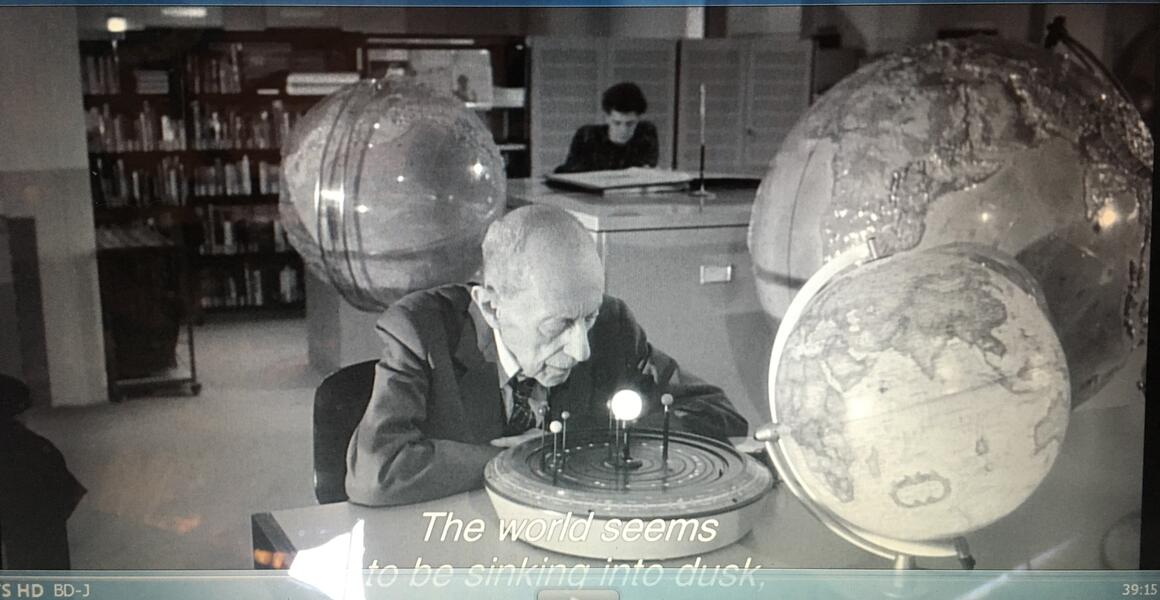 Homer in thought
Homer in thoughtClose up still image of Homer daydreaming of peaceful times. We can hear his thoughts.
Fahrenheit 451 vignette
This is one of a six part sculptural series of library scenes represented in film, television and literature. This vignette combines materials of varying scales in which the Victorian parlor is depicted in Ray Bradbury's book and Francois Truffaut's 70's movie version. A three tier bookcase becomes the various levels of a Victorian parlor and a woman's forbidden library in the attic. Again, a play on scales with classic books on the upper and lower shelves, while a miniature bookcase is revealed on the upper "attic" level. This is the forbidden library in a not too distant future when it is illegal to read or own a book. Reminiscent of Stasi led Germany and the current assault on education and culture as we know it. Libraries are losing their significance. The middle tier is the miniature vignette after the "firemen" have discovered the library in the attic and have thrown the books over the railing - this is just before the house is set afire. A powerful scene turns the power around when the woman takes out her own match, taking control from the "firemen" awaiting to make an example of her.
The scene is a one inch to one foot scaled miniature made of steel, copper mesh, paper books, a marble, vintage keys from Nuremberg and a child's silver spoon.
16" wide x 12.5" deep x 43.5" tall
-
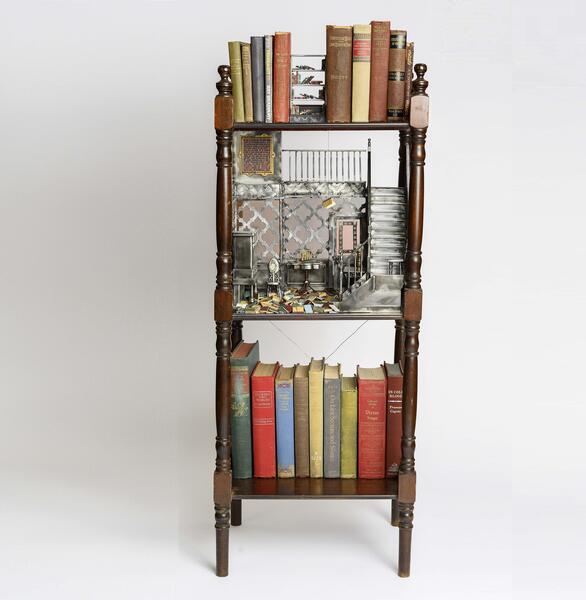 Fahrenheit 451
Fahrenheit 451Based on Ray Bradbury's novel and Francois Truffaut's 1960 movie of the same name. The scene just before a library full of classic novels and academic texts is set on fire...ON PURPOSE
-
 Glowing lamp globe with falling book
Glowing lamp globe with falling bookClose up of the miniature Victorian parlor scene. Lamp post with glowing globe - a marble. A tiny book falling to the floor already covered in books.
-
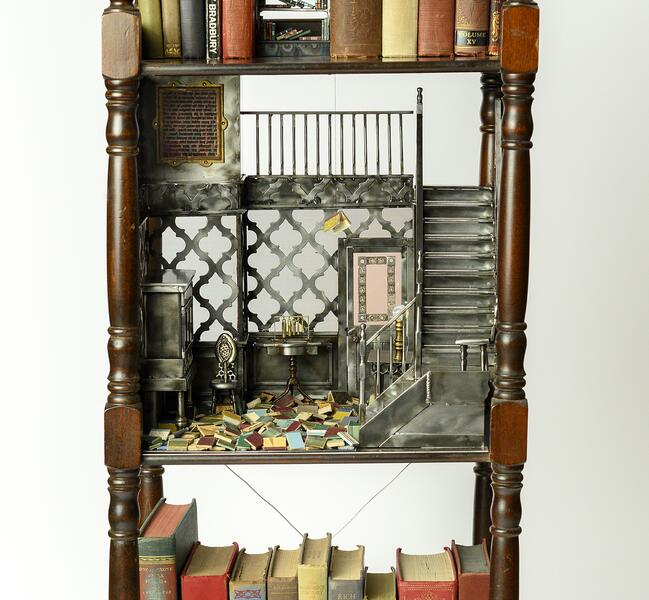 Fahrenheit451 close up of Victorian parlor
Fahrenheit451 close up of Victorian parlorThe middle/main section of the full sculpture. Above it is a tiny bookcase set among full sized books and below are more full sized books. The full sized books are titles and authors that are seen in the Francois Truffault directed movie. I carefully chose these books as they are some of the ones seen in the film falling from the balcony that the firemen are throwing from the hidden attic.
-
 Fahrenheit 451 - stair landing chair
Fahrenheit 451 - stair landing chairThe miniature chair back on the landing is made using a vintage key from Nuremberg, Germany. The legs are created using rusty bolts turned in an electric screw driver against a belt sander.
-
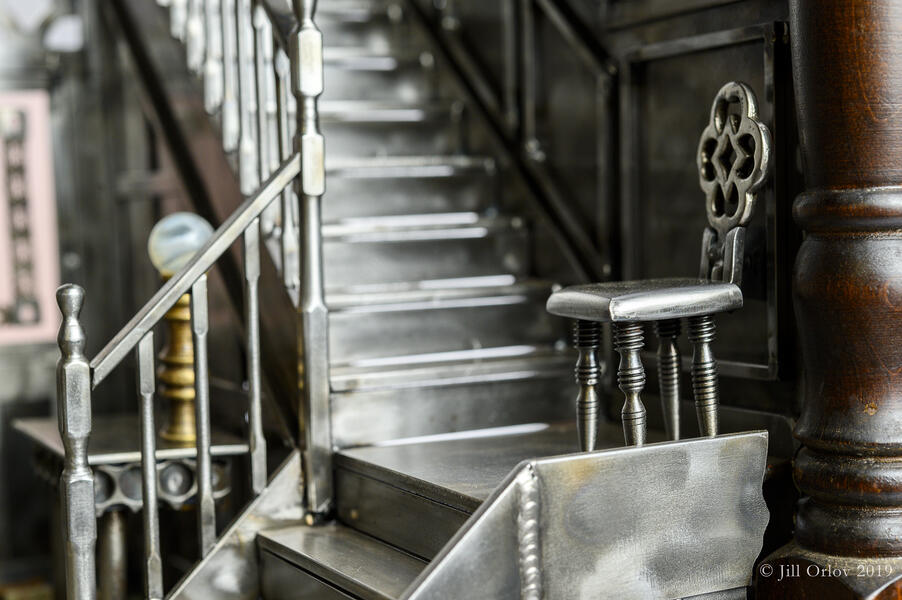 Fahrenheit451 stair landing chairMarble used for lamp, brass lamp finial repurposed for the miniature lamp
Fahrenheit451 stair landing chairMarble used for lamp, brass lamp finial repurposed for the miniature lamp -
 Fahrenheit 451 armoire and dinner bells
Fahrenheit 451 armoire and dinner bellsArmoir, parlor chair, and dinner bells in the Fahrenheit 451 parlor scene. This chair back is made from a child's silver spoon. The legs of the "large, but tiny" cabinet are made from the shafts of the Victorian keys procured for the chair on the landing that is not in this view.
-
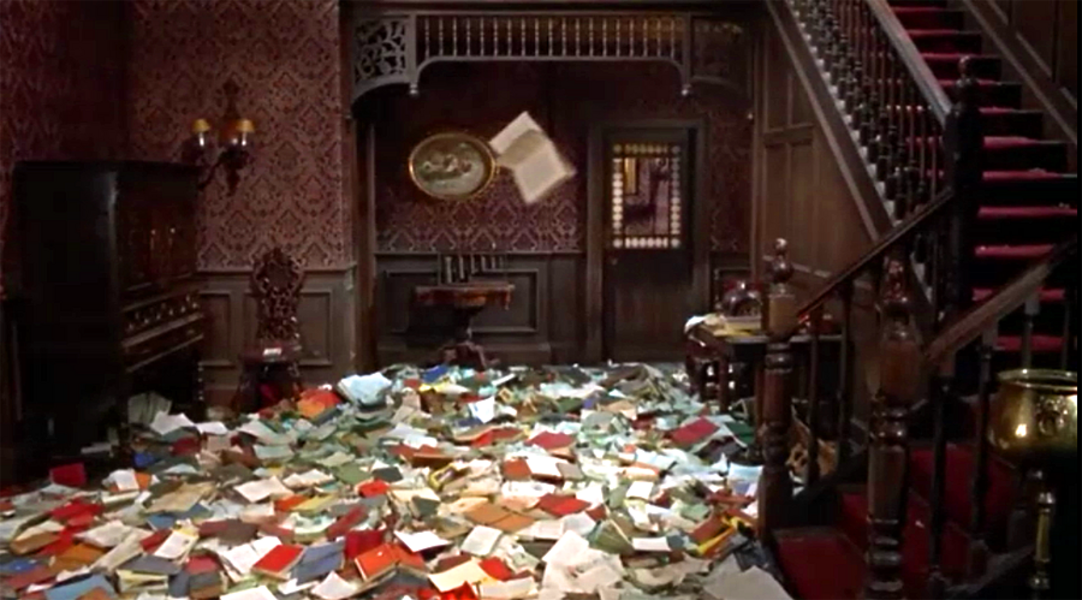 fahrenheit_451_truffaut22.png
fahrenheit_451_truffaut22.pngReference photo of Francois Truffaut's 70's movie version of Fahrenheit 451
-
Vintage keys from Nuremberg, Germany
Sourced directly from Nuremberg, Germany.
Time Enough at Last - vignette from Twilight Zone episode of same name
During some of my travels, I visit the historic libraries of the towns and cities, finding their inherent beauty to be peaceful places of culture, community, and learning.
Nearly everything is either made of or made to look like BOOKS! Banning and censoring books are some of the first steps taken to create an autocratic society to keep people in line and not question authority.
This miniature vignette was inspired by episode 8, season 1, of the Twilight Zone, released on November 20, 1959, and directed by Rod Serling. The same set, located at MGM in California, was used for the 1960 movie version of H.G. Wells' The Time Machine. I recreated the ruins in steel. The original loosely resembles the New York Public Library evidenced by the overturned arch. The grand stair represents a stack of books realigned, the risers are reminiscent of page edges. The spines of the books, listed on the side of the vignette, are titles referenced in the episode, other Twilight Zone episodes, or favorites of Rod Serling. Stainless steel mesh is used to represent the fabric covering of hardback books. I combined the scene of the vault with the library steps. The vault represents four books without covers making up the thick walls. The exposed pages are made of vintage printer plates and wire. The vault door locks and gears are clock and watch parts.
Henry Bemis, a bank clerk, just wanted to read, his favorite pastime. Wanting to talk about what he was reading, Mr. Bemis’ boss, bank customers, and even his wife just didn’t understand. So he would lock himself in the bank vault during lunch time, with newspaper tucked under his arm. While in there, an explosion happens (barely noticeable, the newspaper headline had said “H-BOMB C…). Picking himself up after being knocked off his chair, he ventures out of the vault. Total destruction. The bank, his town…all rubble. He finds the remnants of a grocery store and feels reassured he can survive but as he wanders through the ruins, despair starts to set in…until he sees the sprawling steps of the public library. Books tumbled down the steps. With excitement, he starts stacking his favorite novels in the world…January, February, March…Time Enough at Last he says dreamily as he notices the Library Clock…but once he sits and reaches for his FIRST book to read, his glasses fall from his face and the lenses crack. By far one of the most eerie endings on film.
26" wide x 13" deep x 13.5" tall. 2019.
-
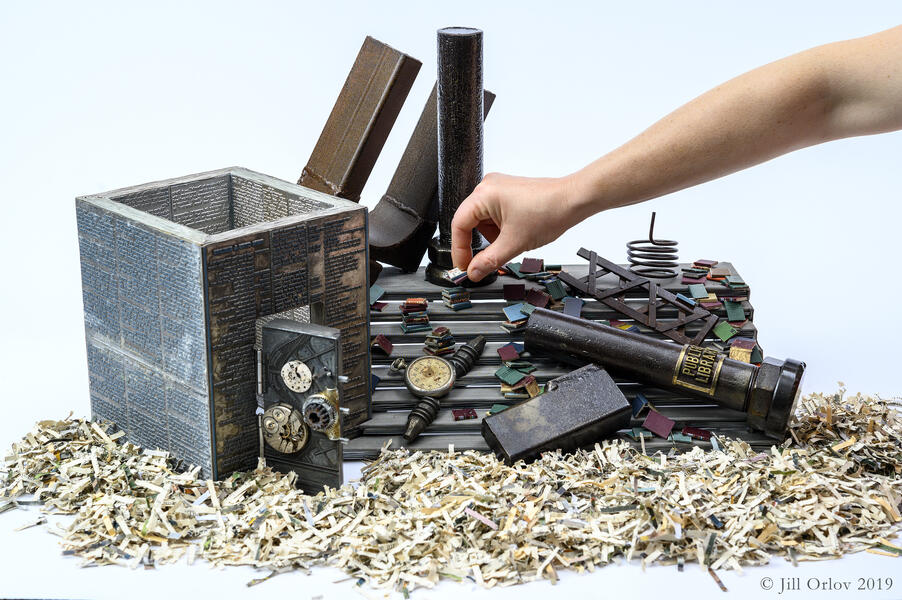 Time Enough at Last - Twilight Zone
Time Enough at Last - Twilight ZoneOverall sculpture comprised of two scenes - an early one embedded into a later one.
Available for Purchase -
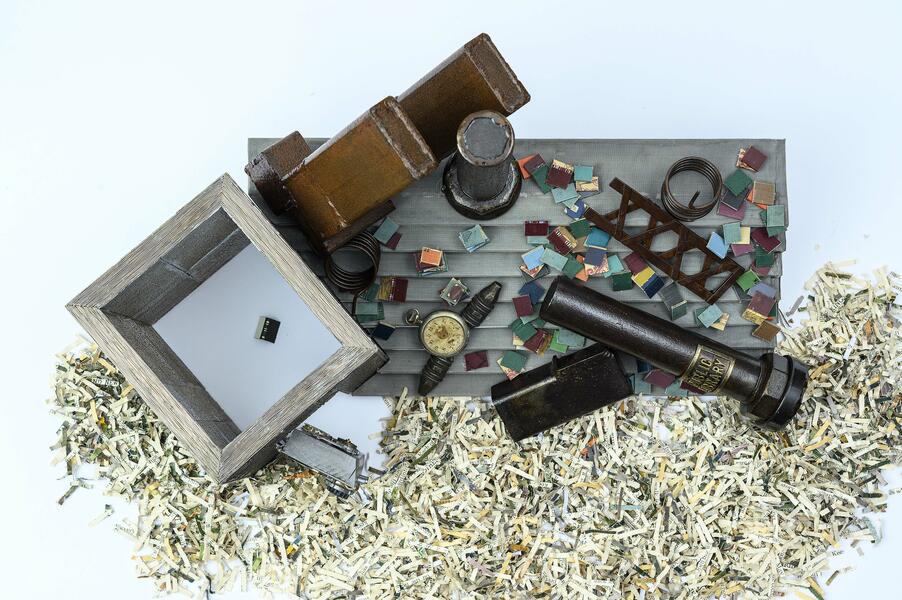 Time Enough at Last - Twilight Zone from above
Time Enough at Last - Twilight Zone from aboveA bird's eye view of the sculpture representing two scenes combined in this vignette miniature inspired by the Twilight Zone's episode called Time Enough at Last
-
 Twilight Zone - Time Enough at Last book spine steps
Twilight Zone - Time Enough at Last book spine stepsA History of the Life and Voyages of Christopher Columbus by Washington Irving (the book he’s reading in the bank vault), David Copperfield by Charles Dickens (the book he’s currently reading as a bank teller), The Pedestrian by Ray Bradbury (a story of a book-less, television-centered world of the future), Storytellers Unplugged by Weston Ochse (Wikipedia references this author’s theory that we are delicately tied to technology which could easily fail but the irony in this episode is that it was the fragility of his glasses that led to his demise), To a Mouse by Robert Burns (Rod Serling alludes to this poem in the closing statement of the episode), William Shakespeare (one of Bemis’ favorite authors as he starts planning his future reading), The Obsolete Man (another Twilight episode with Burgess Meredith, a librarian, in which reading is obsolete) Rod Serling!! Lastly, nearly everything in this vignette is made from a book or represents a book.
Available for Purchase -
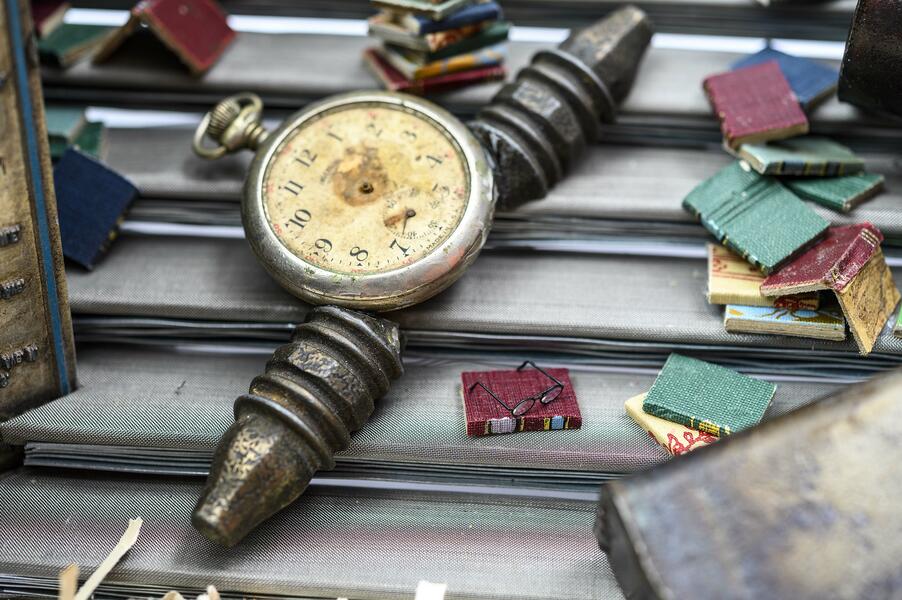 Time Enough at Last - clock and glasses
Time Enough at Last - clock and glassesThe clock in this vignette is made of a pocket watch and a brass drawer handle. The miniature eyeglasses are a dollhouse accessory made in Italy. Close up of the steps subtly depicted as books.
Available for Purchase -
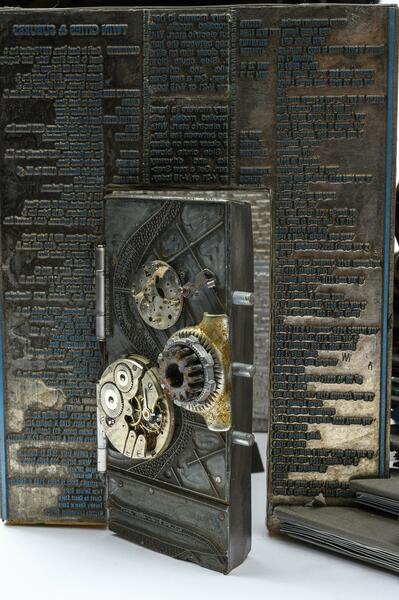 Time Enough at Last vault door
Time Enough at Last vault doorThe vault walls represent four books without their covers. Mr. Bemis gets absorbed in his book, both literally and figuratively. It is fabricated from vintage printer plates, watch parts and gears, and wire.
Available for Purchase -
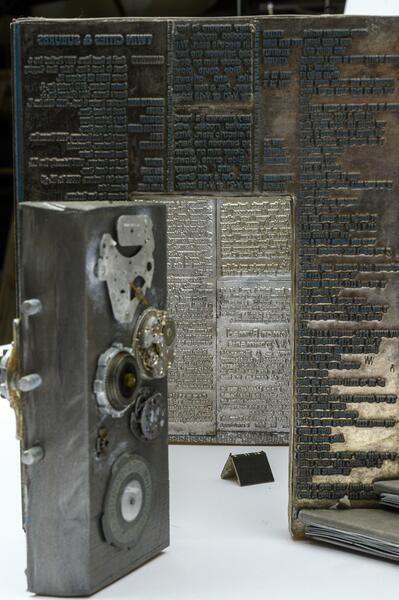 Time Enough at Last - vault open
Time Enough at Last - vault openMr. Henry Bemis' book left behind as if he was just there
-
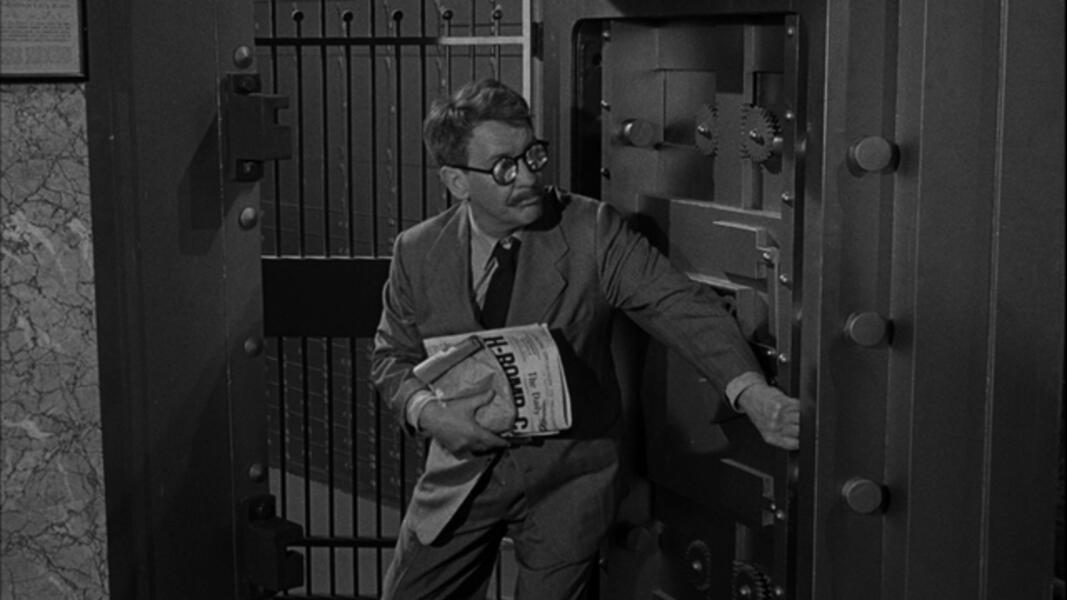 time enough reference photo - vault door.jpg
time enough reference photo - vault door.jpgReference photo from Twilight Zone episode "Time Enough at Last" with Burgess Meredith as bank clerk, Mr. Henry Bemis
-
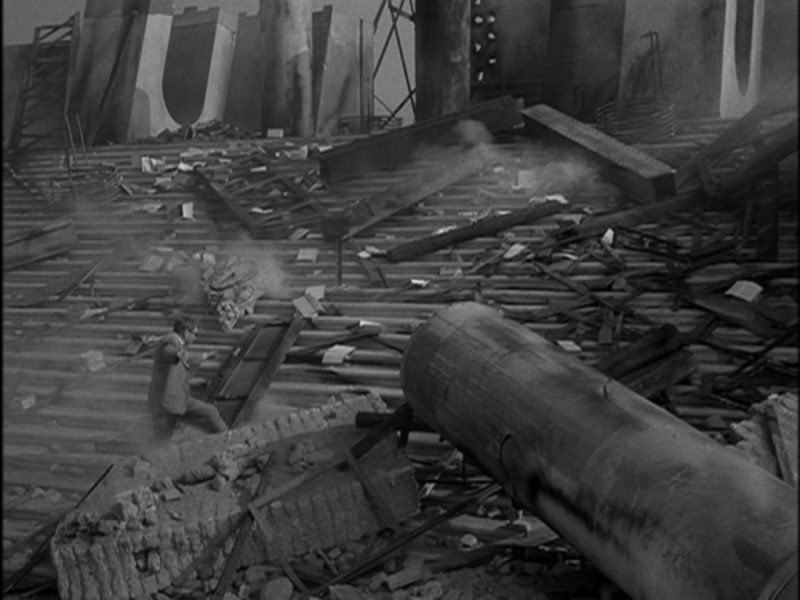 Time Enough at Last - still reference photo - overall steps
Time Enough at Last - still reference photo - overall stepsStill reference photo from Twilight Zone episode "Time Enough at Last" with Burgess Meredith. The upper left corner shows an upside down arch, alluding to the New York Public Library. The same set was used for The Time Machine made at MGM in Los Angeles.
-
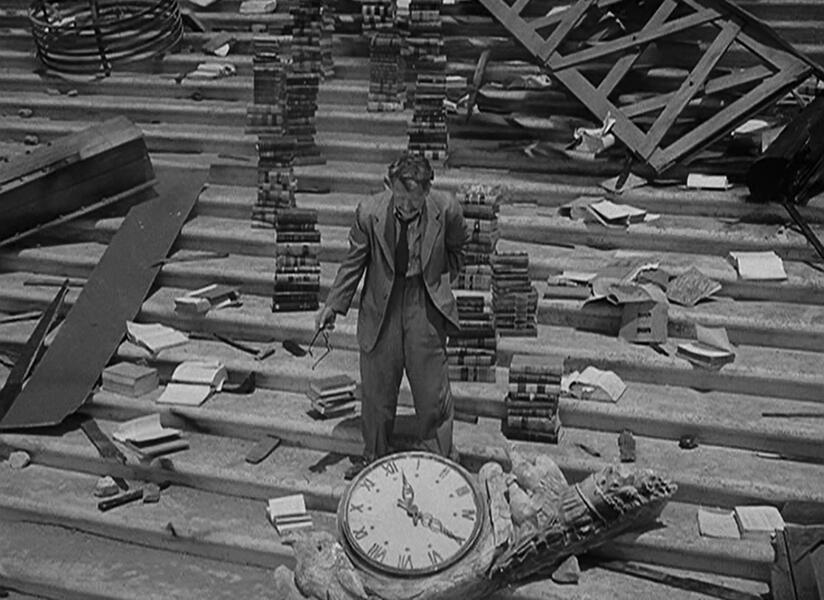 Time Enough at Last still reference photo - clock
Time Enough at Last still reference photo - clockStill reference photo from Twilight Zone episode "Time Enough at Last" with Burgess Meredith. The upper left corner shows an upside down arch, alluding to the New York Public Library. The same set was used for The Time Machine made at MGM in Los Angeles.
Former bank clerk, Henry Bemis, stares at the fallen town clock realizing he has all the TIME in the world
-
 Time Enough at Last reference photo - library column
Time Enough at Last reference photo - library columnReference photo from Twilight Zone episode "Time Enough at Last" with Burgess Meredith staring at the fallen column of the public library
Breakfast Club
A miniature vignette set within a full scale book. All handmade and all the old adages, don’t judge a book by it’s cover and then these kids in detention! The Princess, The Athlete, The Brain, The Criminal, and The Basket Case each become open books with each other even though they are worlds apart at the beginning of the classic (albeit a few too trite moments and a disturbing #metoo scene) 80's movie.
The full scale book is made of vintage newspaper printer plates, metal straps, and heavily rusted steel plates evoking a leather bound book. The scene is set within a high school library and is part of my six miniature vignettes based on library scenes in film, literature and television series.
Each student in detention is represented by items left behind on the desks or the empty chairs. Claire, The Princess, with a bento box lunch; Andrew, The Athlete, with a letter jacket from Sherman High School; Brian, The Brain, with a stack of books spilling out of a backpack; Allison, The Basket Case, with her drawing of a covered bridge in winter; and John Bender, The Criminal, with his knife and pocket chain. The library sculpture (in the movie, called "Standing Figure: Knife Edge" by Henry Moore) is represented in miniature and made by combining different sized cast steel fence finials.
20" wide x 17" deep x 11.5" tall. 2019.
-
 Breakfast Club - library within a book
Breakfast Club - library within a bookFull view of open book as setting for tiny desks and chairs.
Available for Purchase -
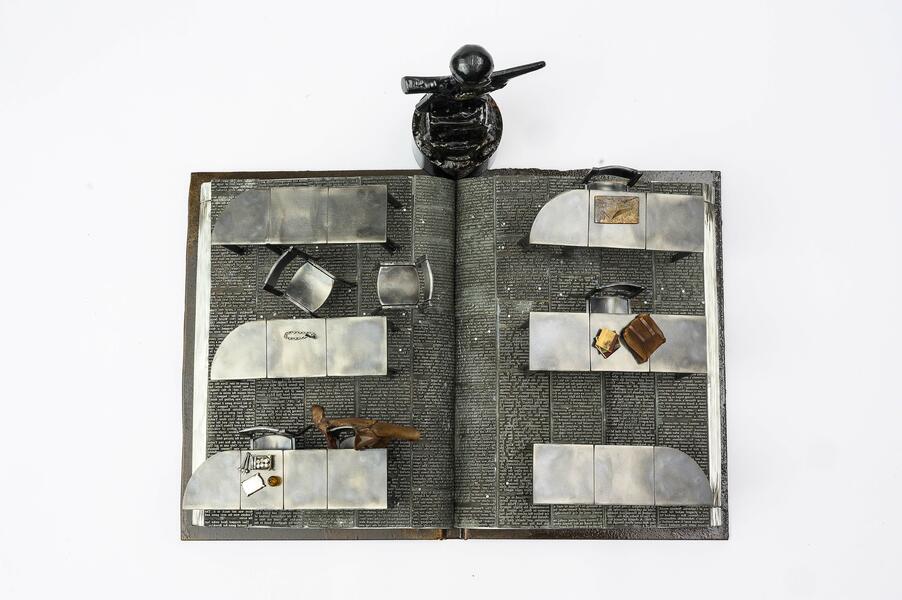 Breakfast Club birds eye view
Breakfast Club birds eye viewBird's eye view of the empty chairs representing each of the five students (John Bender, The Criminal, took two).
Available for Purchase -
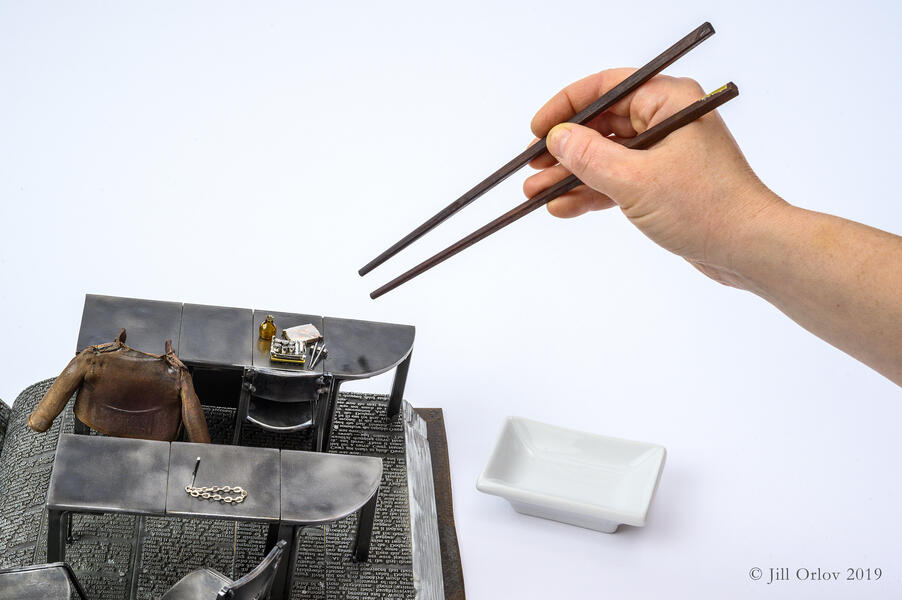 Breakfast Club big chopsticks and little chopsticks
Breakfast Club big chopsticks and little chopsticksBreakfast Club - chopsticks for scale pointing at The Princess's (played by Molly Ringwald) spot with her Bento box lunch.
To get an idea of the scale, the bento box lid is made from a bracelet bezel link and the chopsticks are made from finishing nails.
Available for Purchase -
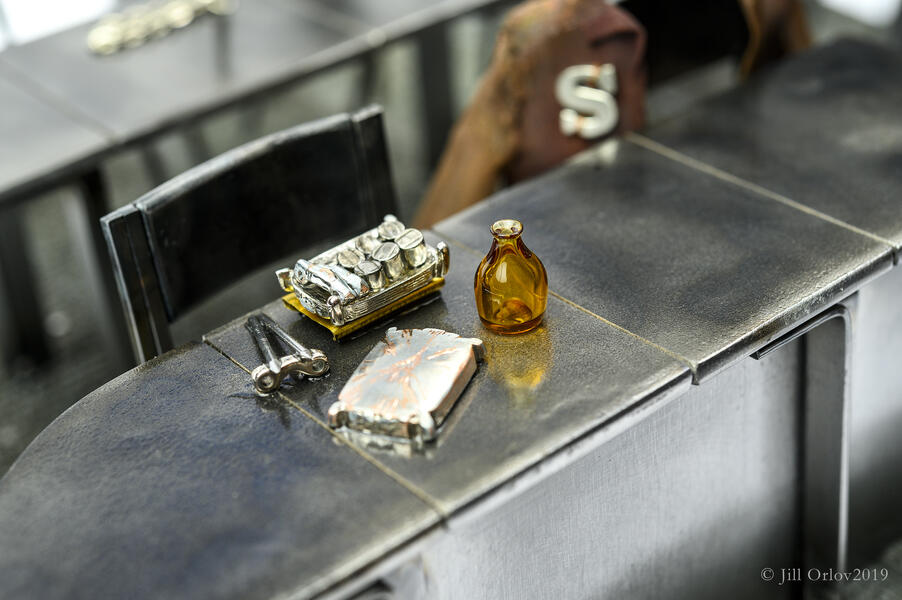 Breakfast Club sushi bento box
Breakfast Club sushi bento boxA close up of Claire's (played by Molly Ringwald) sushi lunch, complete with soy sauce bottle, and of Andrew's varsity letter jacket in the background.
Available for Purchase
The Time Machine
These stacked vignettes are inspired by H.G. Wells’ 1895 novel and visually from the movie adaptations of the same name. Each is housed in a vintage card catalog drawer except the top scene in which represents the time traveller’s laboratory. The scene of the Eloi in the original movie, filmed in 1960 at MGM in California even though it was set in London. The modern remake from 2002 has a scene when George is walking in front of the New York Public Library’s steps and the lions. The story has many levels (literally) – the haves and the have-nots – the above ground people are delicate and lounge around with not a care in the world (except at night) and eventually he learns about the below ground workers who make the world above work. George invites friends and colleagues over for dinner but he isn’t there when they gather at his home. He has travelled to the year 802,701 and meets the Eloi. He asked if they have books so he can learn about them. As the others lounge about outside, a small woman guides him into the large building– a shell of a former library. Hoping to learn about these people of the far future, he pulls a book from the shelf. As he opens the book, it disintegrates in his hands. He sullenly realizes that, yes, the books do tell all about their history. After going back and forth into time, including a time 30 million years ahead, he returns to his dinner party to tell them about his adventures. They don’t believe him. The housekeeper shows his friend the library – three books are missing. He wants to rebuild the future that he has seen. Is it a time of innocence and complacency or is it so idle and satiated that it has become prey? An ending not as eerie as the Twilight Zone but…
We are in times of book banning and censoring critical thinking. Some are vilifying words and phrases such as social justice, critical theories, and democracy. We have been down this road before, many times. What type of world will we end up with if it is simplified down to function and basic survival.
The New York Library lion, Fortitude, rests atop the miniature scenes representing the various levels down to the Morlocks who make the world run above, made of heavy gears reminiscent of the machinery in the silent movie Metropolis.
15.5" wide x 18" deep x 53" tall. 2019.
-
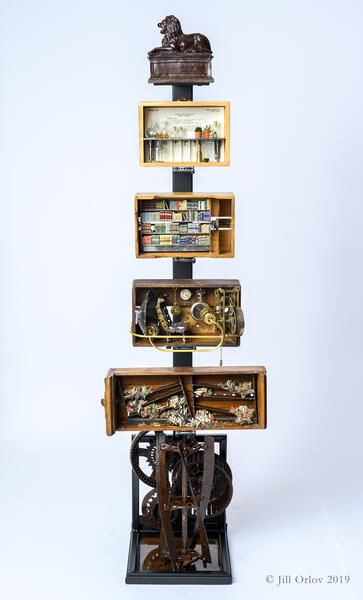 The Time Machine
The Time MachineClose up of the four vignettes connected on a spine. The top is a laboratory set within a testing kit box while all the others are set within vintage library card catalog drawers. Each spins evoking the movement of The Time Machine.
Available for Purchase -
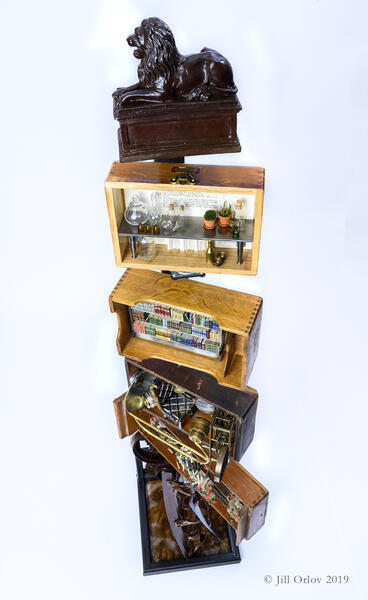 The Time Machine spiraling down
The Time Machine spiraling downThe sequence starts at the top with the New York Public Library lion, then the science lab (represented from the most recent "unwatchable" 2002 movie version) set in a science lab kit box; the next three "scenes" are set within library card catalog file drawers: the "current" intact library of The Time Traveller, the actual "time machine", the library far in the future turned to dust; and lastly, the gears and motors representing the Morlock level at the base below
Available for Purchase -
 The Time Machine laboratory
The Time Machine laboratorySet in a science lab test kit box - the only scene somewhat based on the 2002 version of the film.
Available for Purchase -
 The Time Machine library - the day the Time Traveller left
The Time Machine library - the day the Time Traveller leftThe miniature library intact except for the three books The Time Traveler returns to take back with him into the distant future. Which books?? The vignette is set within a library card catalog file drawer
Available for Purchase -
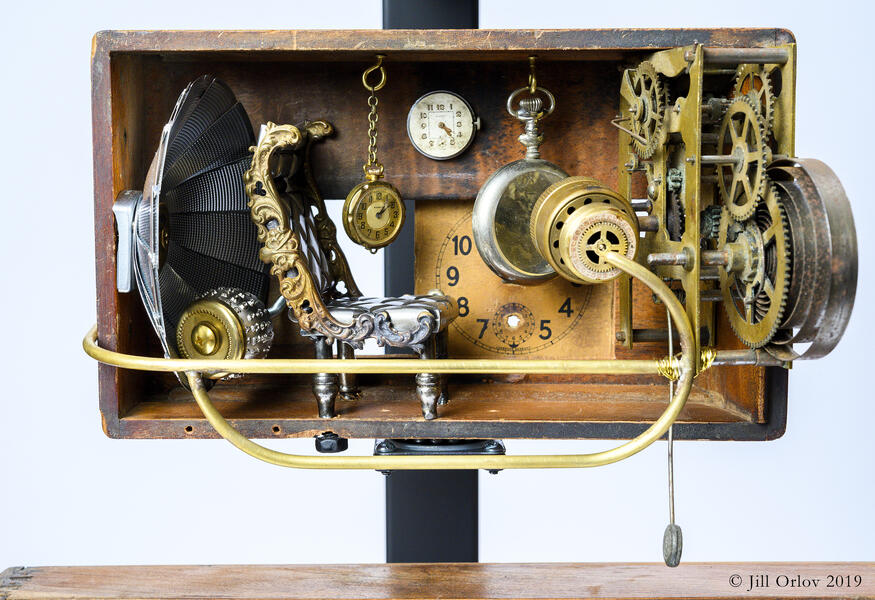 The Time Machine
The Time MachineThis vintage library card catalog drawer houses the actual Time Machine. It is made of a camera flash reflector; typewriter ball (Times New Roman, of course); clock and watch parts; brass rods, wire and drawer pulls. The chair itself is made of steel and two Victorian cast brass drawer handles.
Available for Purchase -
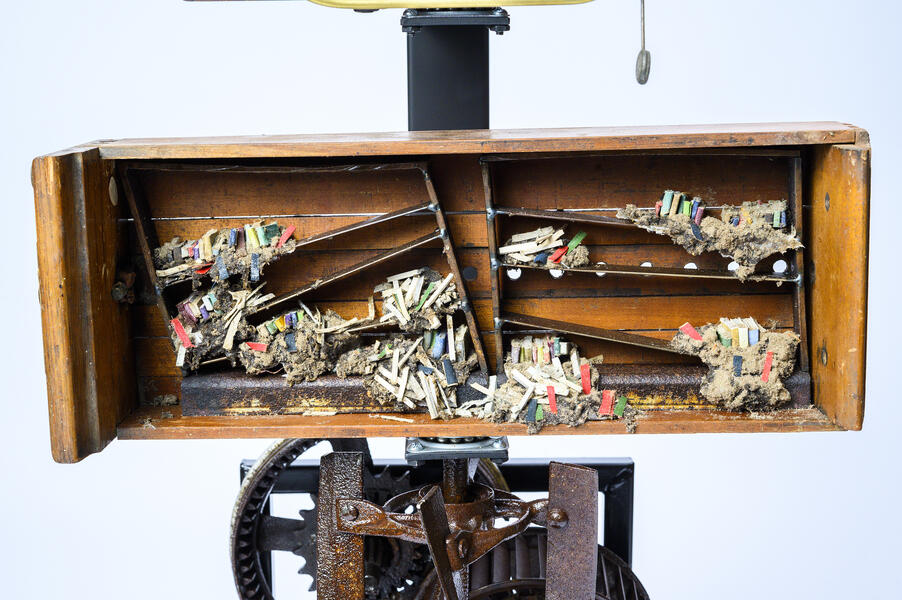 The Time Machine - future library in shambles
The Time Machine - future library in shamblesThis is the library of the distant future, unless we realize the importance of books, reading, and LIBRARIES. They turn to dust in our hands if left to be forgotten.
Available for Purchase
All The President's Men in the Library of Congress
Viewers and fellow artists alike are empowered to challenge their preconceived notion of momentous spaces and times. My work beckons viewers to inhabit the look and feel of more hopeful futures which may have been squandered by unjust systems. Paradoxically, a mind finally finds room inside miniature spaces to explore society’s largest questions.
This is the final sculpture in the series of six vignettes inspired by library scenes in film, literature and television. The opening scene within the dome of the Library of Congress, starts zoomed in on Bob Woodward (played by Robert Redford) and Carl Bernstein (played by Dustin Hoffman) pouring over checkout slips for every White House request since 1971. Piles of checkout requests, the size of card catalog slips, spill out on the desk in front of the two reporters from the Washington Post about to break Nixon's Watergate. the scene slowly pans out and up into the dome. The view of the concentric desks of the main reading room reminded me of the vast "roller coaster" of newspaper conveyor belts.
24" wide x 13" tall. 2019.
-
 All The President's Men in the Library of Congress
All The President's Men in the Library of CongressThis vignette is set within a wooden foundry form. The concentric desks are made of bicycle chain and fragments of vintage newspaper printer plates of a regularly running column called Tremendous Trifles.
-
 All The President's Men in the Library of Congress - bird's eye view
All The President's Men in the Library of Congress - bird's eye viewLooking down as if up in the dome of the Library of Congress.
-
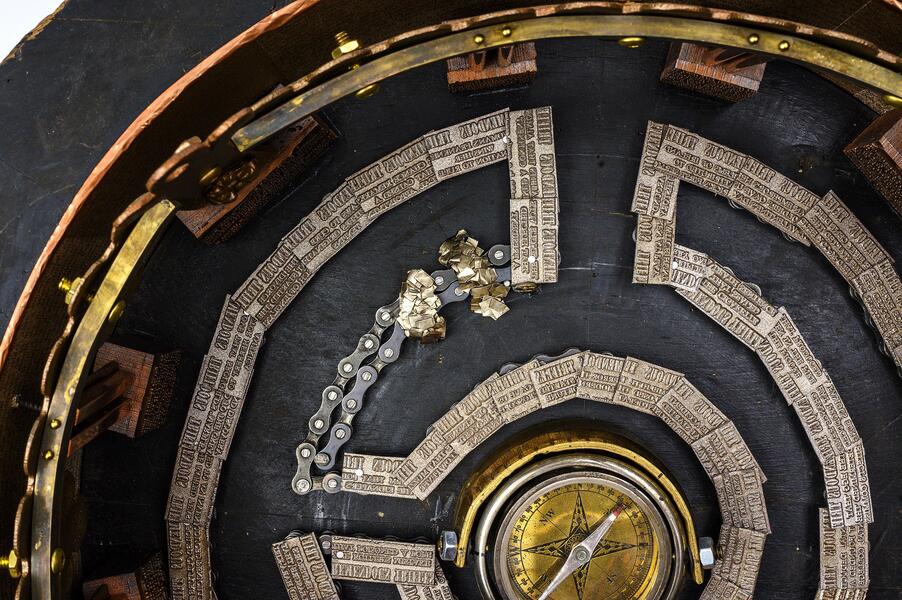 All The President's Men in the Library of Congress - mid zoom
All The President's Men in the Library of Congress - mid zoomThis is zoomed in at mid level - one of the opening scenes starts close to Woodward and Bernstein at the desks and then zooms OUT and up into the dome looking down. The Nixon Whitehouse material requests are depicted as small metal rectangles spilling over the desktop. The desks, set in a concentric circle, are made of bicycle chain as a nod to Bernstein riding his bicycle to the Washington Post every day. The desktops are depicted as the Lede of a vintage printer plates of a newspaper column. Similar in size to look like the flow of one day's edition of the newspaper on the conveyor belt. The gap in the "newspaper" is to show the "breaking" story in the case of Watergate.
-
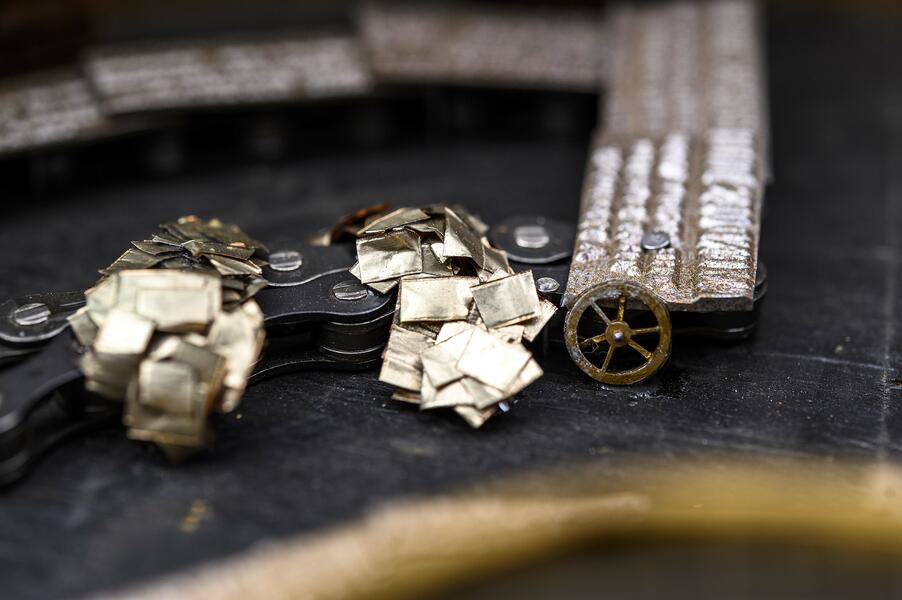 All The President's Men in the Library of Congress - zoomed way in!
All The President's Men in the Library of Congress - zoomed way in!This is the close up of where Woodward and Bernstein would have been sitting. The piles of the library material record files spilling over the desk. The reference of the newspaper conveyor belt has been stopped in this section - the world came to a standstill. For a bit of whimsy, I added Carl Bernstein's bicycle wheel (rendered as a tiny watch gear) since he rode his bike into the Washington Post every day.
-
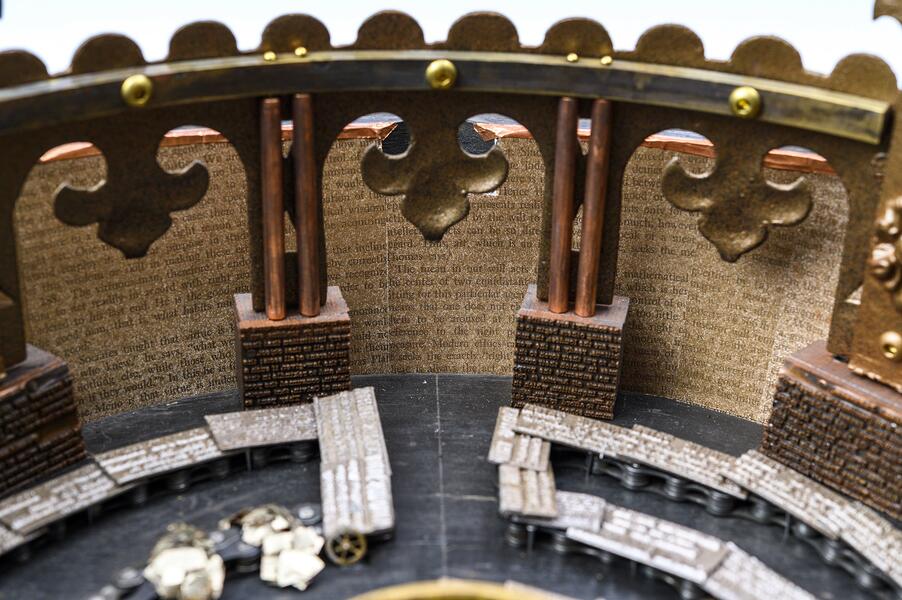 All The President's Men in the Library of Congress - side view
All The President's Men in the Library of Congress - side viewThe column bases in this piece are cut from a vintage book plate of the Continental Congress book with excerpts on President Washington, President Jefferson, President Grant (Ulysses S.), and William Lloyd Garrison (prominent American abolitionist, journalist, suffragist and social reformer). The “newspapers” were magnesium print plates of just the headline of a regularly running newspaper column that might have ran between 1930 and 1950. Most newspaper printer plates were destroyed during WWII, melted down and reused. The background are patina'd pages from a book on ethics in the congressional government.
-
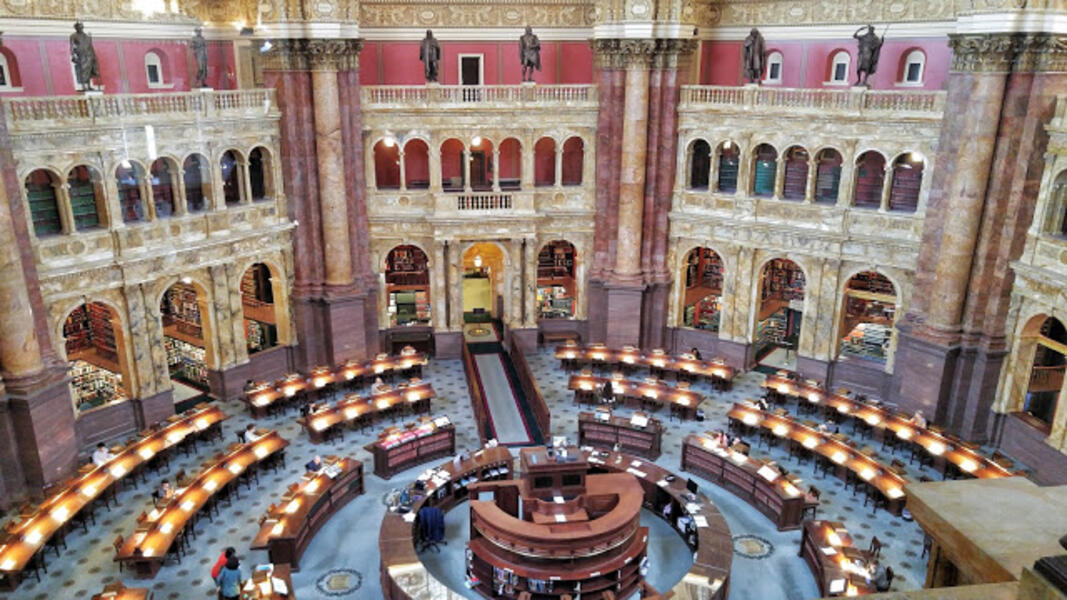 Library of Congress - actual side view
Library of Congress - actual side viewAn interior photograph of the Library of Congress
-
 All The President's Men in the Library of Congress - zoomed in - movie stillAll The President's Men in the Library of Congress - zoomed in - movie still
All The President's Men in the Library of Congress - zoomed in - movie stillAll The President's Men in the Library of Congress - zoomed in - movie still -
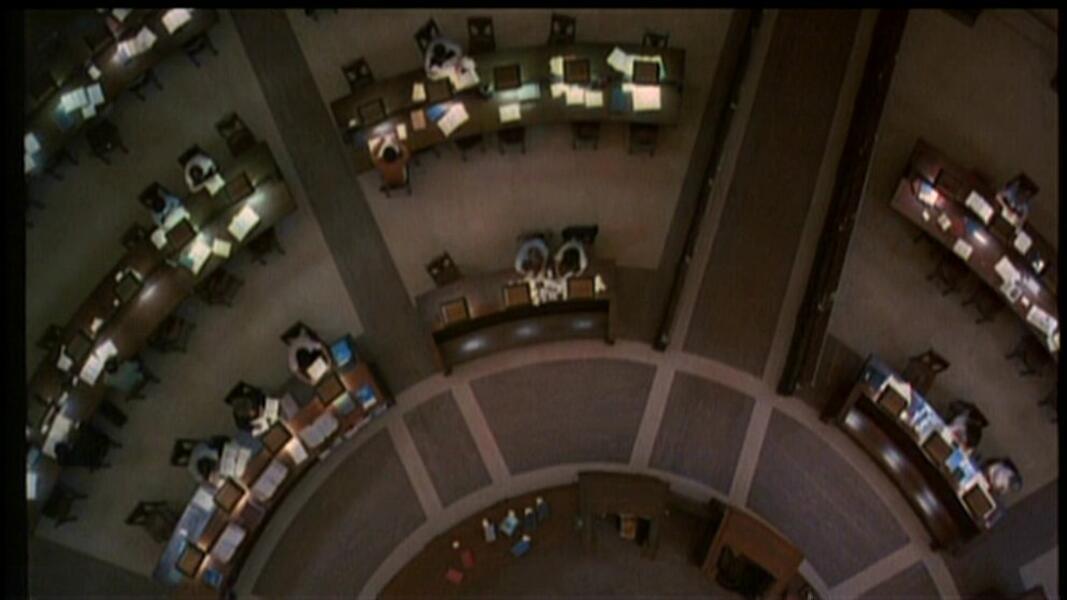 All The President's Men in the Library of Congress - medium zoom, movie stillAll The President's Men in the Library of Congress - camera slowly moving away from Woodward and Bernstein, movie still
All The President's Men in the Library of Congress - medium zoom, movie stillAll The President's Men in the Library of Congress - camera slowly moving away from Woodward and Bernstein, movie still -
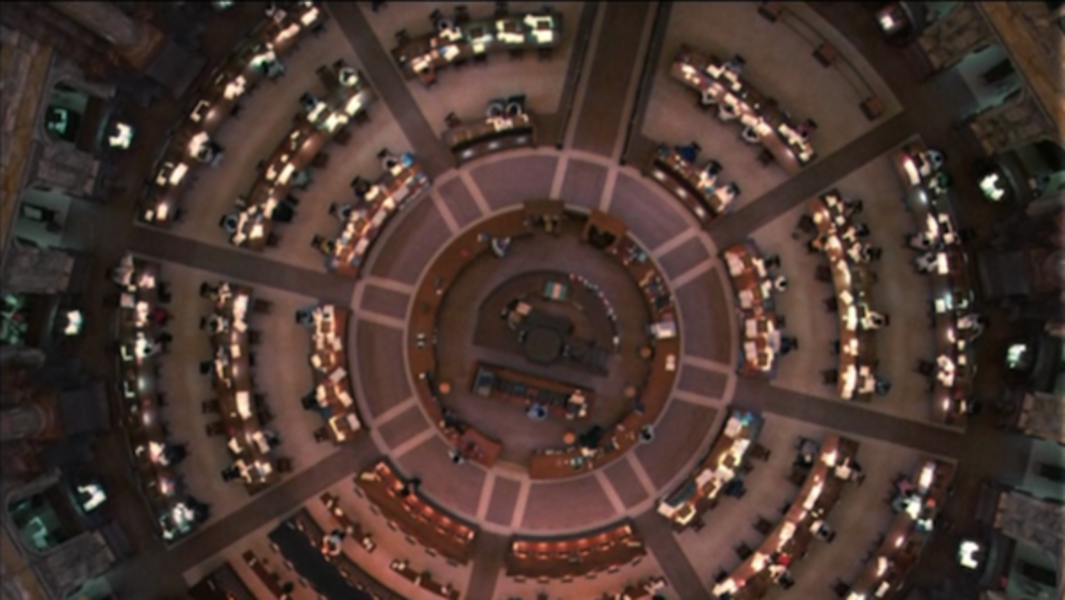 All The President's Men in the Library of Congress - view from domeAll The President's Men in the Library of Congress - zoomed out, view overhead from dome, movie still
All The President's Men in the Library of Congress - view from domeAll The President's Men in the Library of Congress - zoomed out, view overhead from dome, movie still
